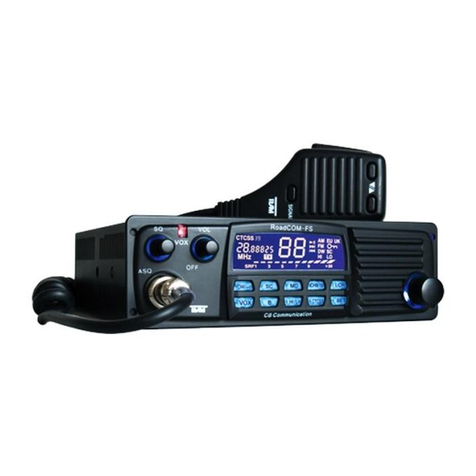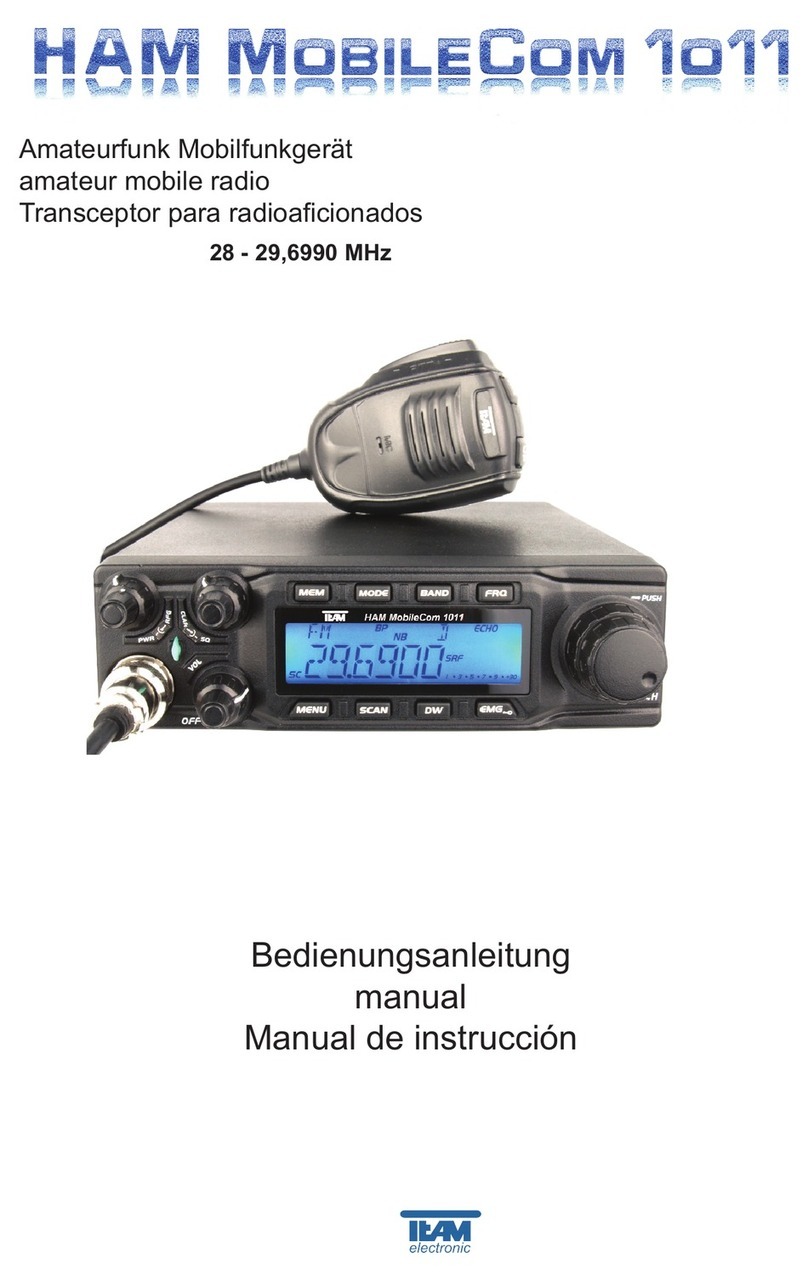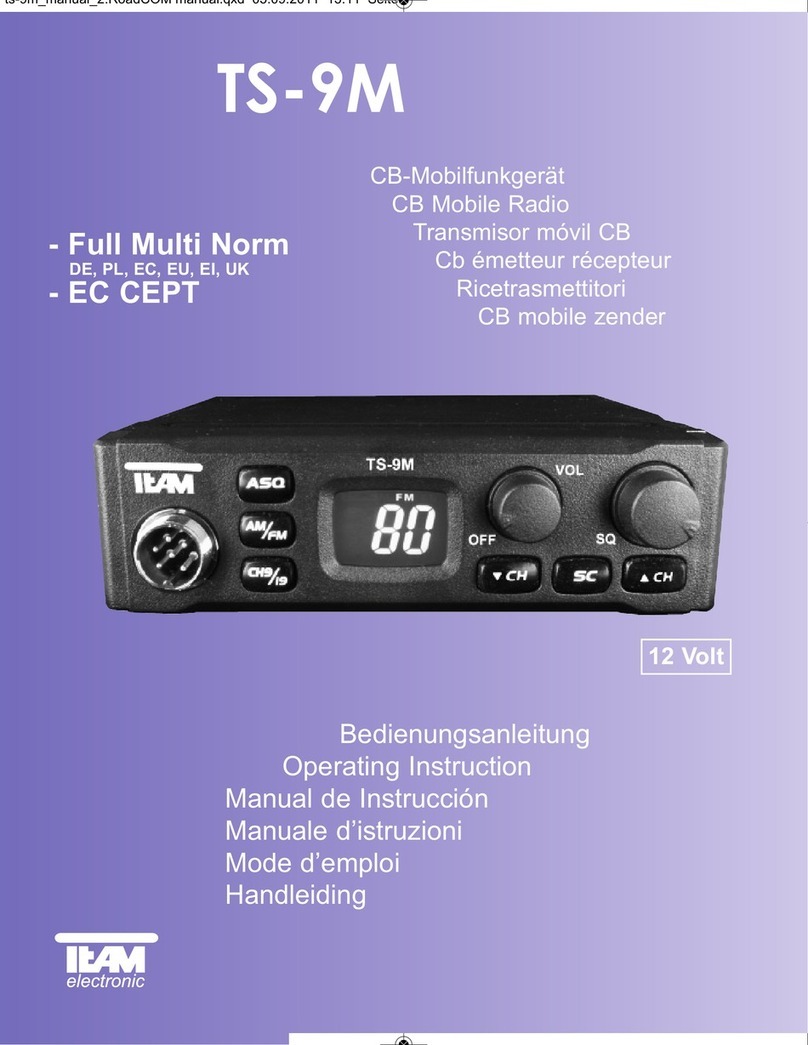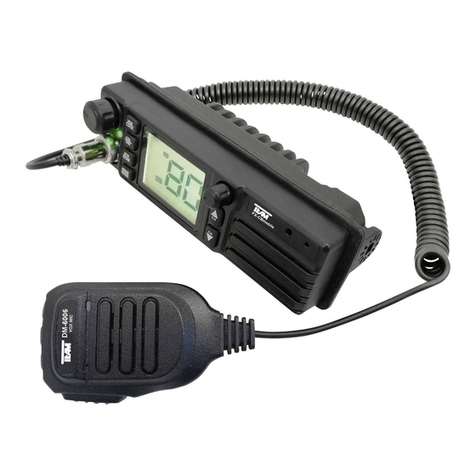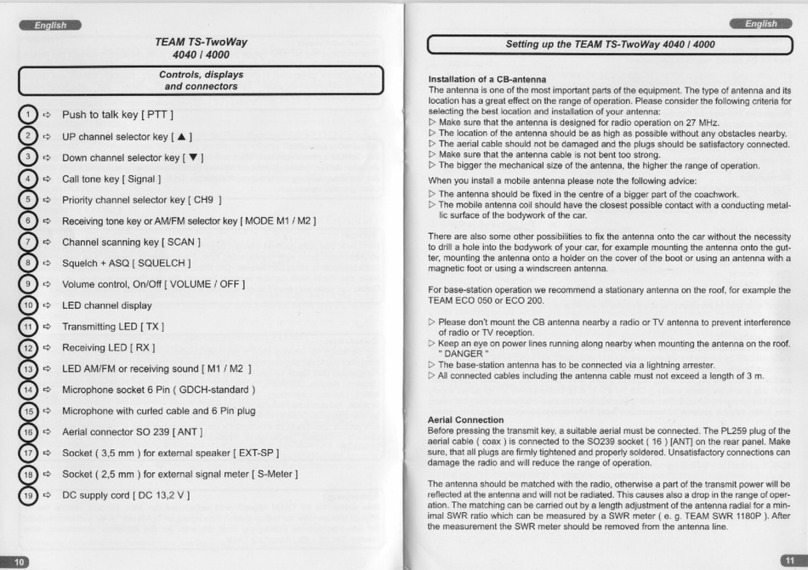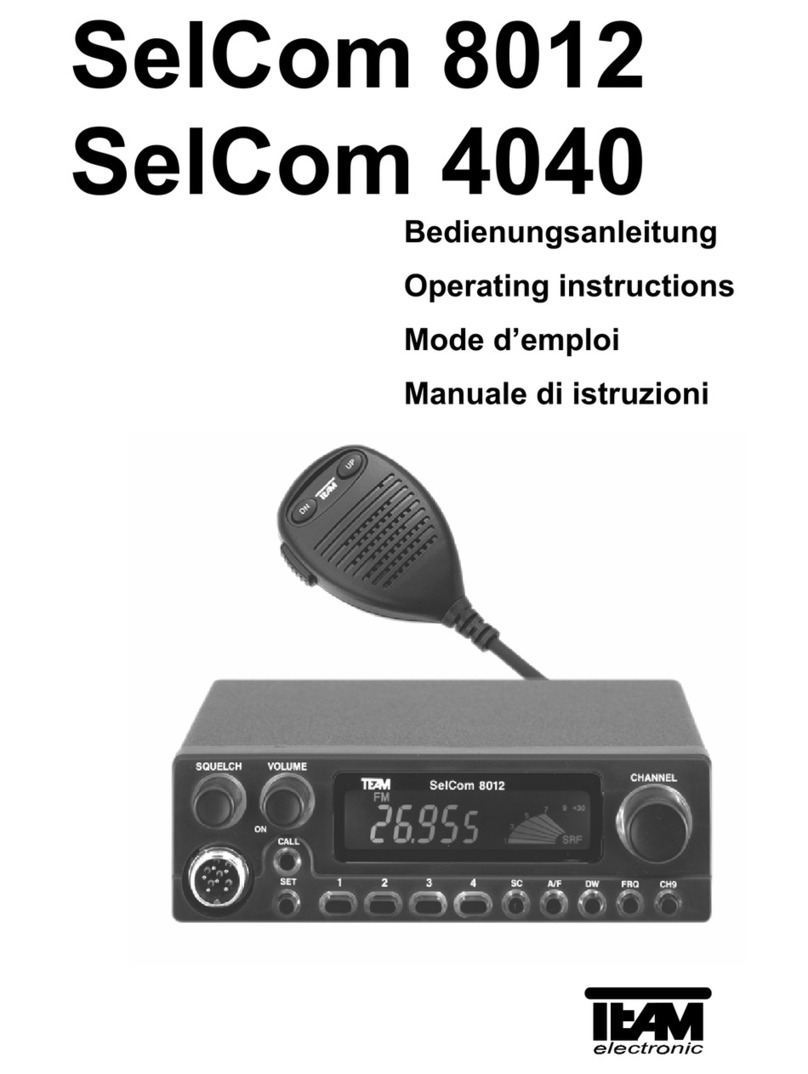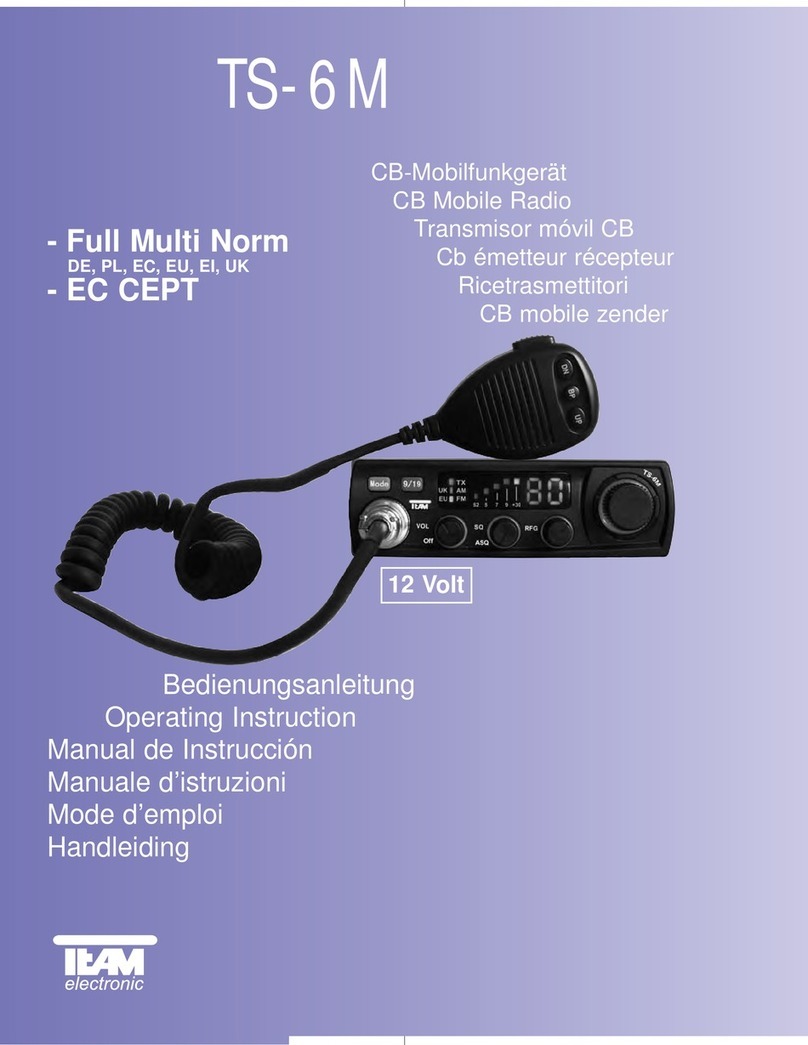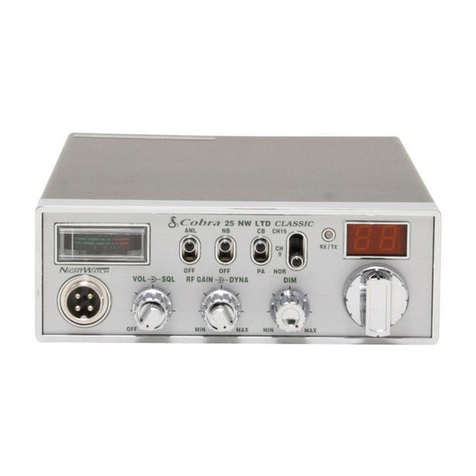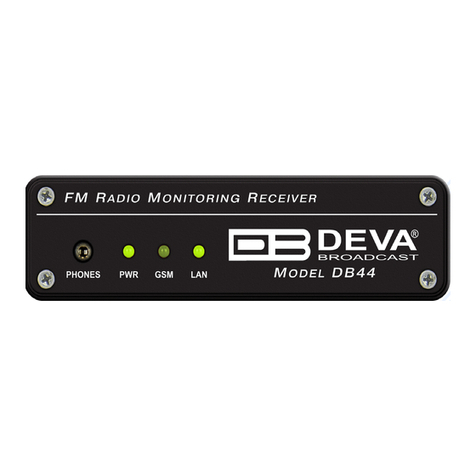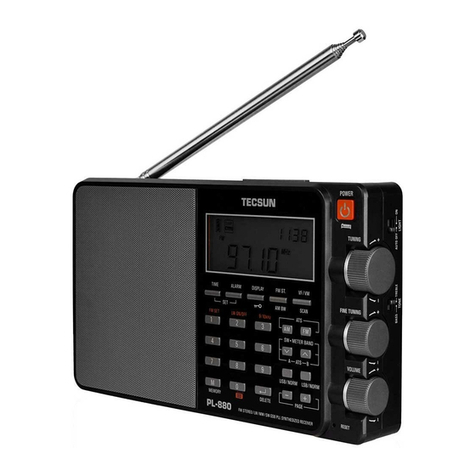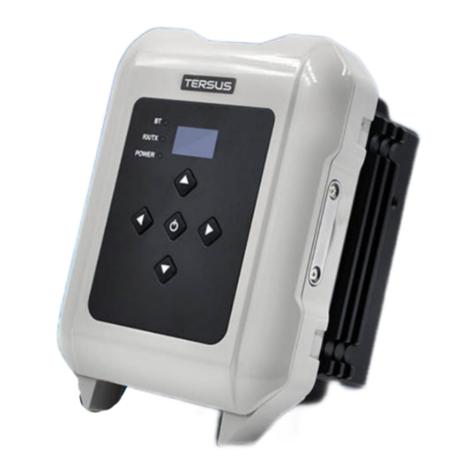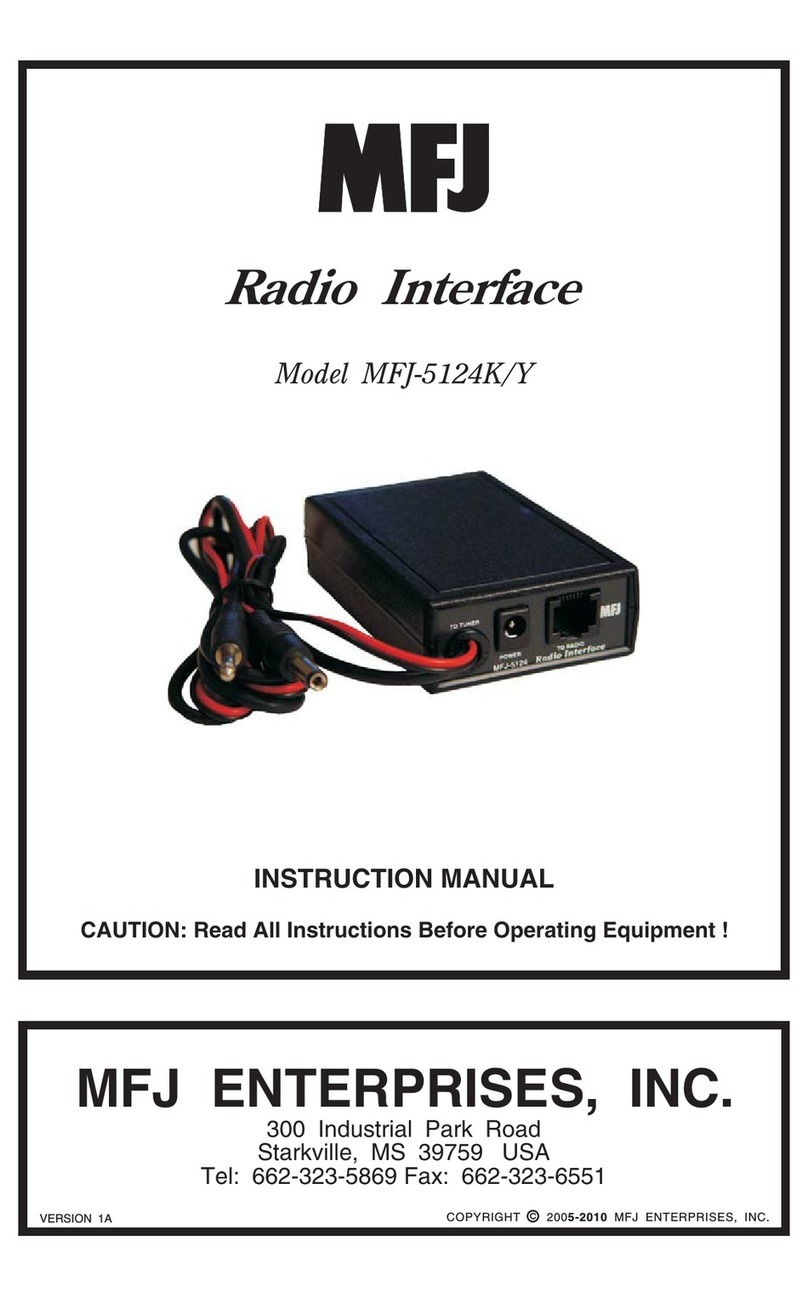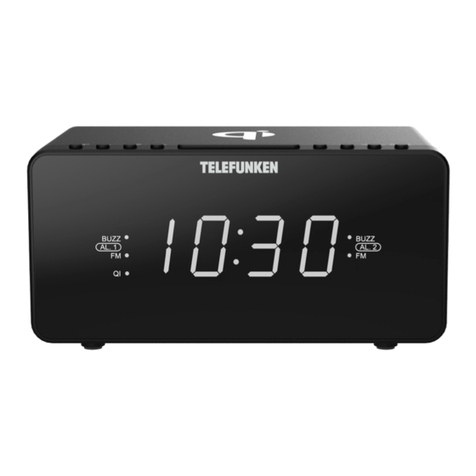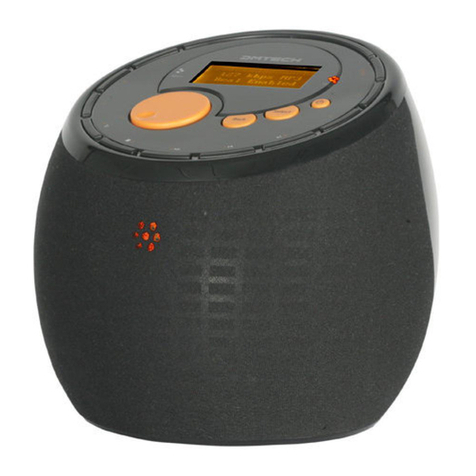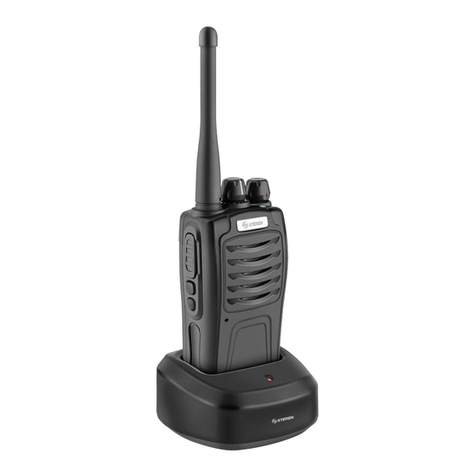Team MX8 Mark-I User manual

Bedienungsanleitung
Operating Instruction
Manual de Instrucción
Manuale d’istruzioni
Mode d’emploi
Handleiding
- EU Multi Norm
DE, PL, EC, EU, EI, UK
- EC CEPT
MX8
Mark-I
CB-Mobilfunkgerät
CB Mobile Radio
Transmisor móvil CB
Cb émetteur récepteur
Ricetrasmettitori
CB mobile zender
12 Volt
mx-8mark1_manual.qxp 14.09.2009 16:44 Seite 1
Downloaded from www.cbradio.nl

6
12
11
13 8
9
14
10
7
1 Micrófono con cable rizado y
conector 6 pin
2 Botón de selector canal/ Arriba [ ]
3 Botón selector canal/ Abajo [ ]
4 Botón pulsar para hablar [ PTT ]
5 Botón tono de llamada [ SIGNAL ]
6 Indicador LCD
7 Selección de modulación / Sonido
Audio Hi-Lo [ Mode ]
8 Botón de exploración de canal o
botón de bloqueo [.SC / KL ]
9 Interruptor selector rotativo de
canal [ Channel ]
10 Interruptor de Squelch + Squelch
automático [SQ/Asq ]
11 Control de volumen,
Encendido/Apagado [ Vol / Off ]
12 Conector de micrófono 6 pin
( GDCH estándar)
13 Doble escucha o botón selector de
iluminación de fondo LCD [DW / B]
14 Botón de prioridad canal 9 / 19
[ CH9 / 19 ]
15 Conector de antena aéreo SO239
16 Cable de alimentación DC
17 Conector Jack ( 3,5 mm ) p ara
altavoces externos
18 Conector Jack ( 2,5 mm ) p ara
S-Meter externo
Español página 20 - 27
Netherland pagina 46 - 53
1 Microfoon met spiraal kabel
en 6 pin plug
2 Kanaal selectie omhoog [ ]
3 Kanaal selectie omlaag [ ]
4 Push to talk toets [ PTT ]
5 Oproeptoon toets [ SIGNAL ]
6 LC display
7 Omschakelen van de modulatie /
toonregeling HI-Lo [ Mode ]
..8 Toets voor scannen van de
kanalen of toetsen blokkering
[SC / KL]
9 Draai schakelaar voor de
kanalen [ Channel ]
10 Squelch bediening + automatische
squelch [ SQ / Asq ]
11 Volume bediening, Aan/Uit
schakelaar [ Vol / Off ]
12 Microfoon aansluiting 6 pin
( GDCH standaard )
13 Dual Watch of keuze toets voor
LCD achtergrond verlichting
[ DW / B ]
14 Kanaal 9 / 19 priority toet s
[ CH9/19 ]
15 Antenne aansluiting SO239
16 DC kabel
17 Jack aansluiting ( 3.5 mm )
voor externe luidspreker
18 Jack aansluiting ( 2.5 mm )
voor externe Signaal meter
1 Mikrofon mit Spiralkabel +
6-Pol Stecker
2 Kanalwahltaste Aufwärts [ ]
3 Kanalwahltaste Abwärts [ ]
4 Sendetaste [ PTT ]
5 Rufsignaltaste [ SIGNAL ]
6 LCD-Anzeige
7 Modulation / Empfangston-
umschaltung Hi-Lo [ Mode ]
8 Kanalsuchlauf oder Tastatur-
sperre [ SC / KL ]
9 Kanaldrehwahlschalter [ Channel ]
10 Rauschsperreregler und
auto. Rauschsperre [ SQ/Asq ]
11 Lautstärkeregler / Ausschalter
[ Vol / Off ]
12 Mikrofonanschlussbuchse
6polig,GDCH-Norm
13 Zweikanalüberwachung oder
Hintergrundbeleuchtung [ DW / B ]
14 Vorrangkanaltaste für Kanal 9 / 19
[ CH9 / 19 ]
15 Antennenanschlussbuchse SO239
16 Stromversorgungskabel
17 Anschlussbuchse für externen
Lautsprecher 3,5 mm
18 Anschlussbuchse für externen
S-Meter 2,5 mm
Deutsch Seite 4 - 11
1
5
4
2
3
18 16
17
32
1 Microfono con cavo
spiralizzato e spina a 6 Pin
2 Tasto selettore canale
UP [ ]
3 Tasto selettore canale
Down [ ]
4 Tasto PTT [ PTT ]
5 Tasto segnale chiamata
6 Display LCD
7 Selezione modalità / Suono
di ricezione Hi-Lo [ Mode ]
8 Tasto scansione canali o
tasto blocco [ SC / KL ]
9 Interruttore a rotazione per
selezione canale [ Channel ]
10 Regolazione Squelch +
Squelch automatico
[ SQ / Asq ]
11 Regolazione volume + inter-
ruttore ON/OFF [ Vol / Off ]
12 Presa microfono a 6 Pin
( GDCH standard )
13 Dual Watch o tasto selezione
retroilluminazione LCD
[ DW / B ]
14 Tasto di canale 9 / 19
prioritario [ CH9/19 ]
15 Connettore SO239
16 Cavo alimentatore
17 Jack (3,5 mm.) per
altoparlante esterno
18 Jack (2,5 mm.) per
S-Meter esterno
Italiano página 32 - 38
1 Microphone avec câble torsadé
et fiche 6 broches
2 Touche de sélection de canaux
vers le haut [ ]
3 Touche de sélection de canaux
vers le bas [ ]
4 Touche d'émission [ PTT ]
5 Touche de la tonalité [ SIGNAL ]
6 Afficheur du type LCD
7 Touche de commutation du fonctionne-
ment AM/FM / ton de réception Hi-Lo
[ Mode ]
8 Touche de la recherche de canaux et
de la verrouillage du clavier [SC / KL]
9 Sélecteur rotatif de canaux [Channel ]
10 Réglage et marche / arrêt du squelch et
squelch automatique [ SQ / Asq ]
11 Réglage du volume et marche /
arrêt [ Vol / Off ]
12 Prise du microphone 6 broches
( standard GDCH )
13 Touche de contro de deux canaux et
touche de sélection de l'éclairage de
l'afficheur LCD [ DW / B ]
14 Touche canal 9 / 19 prioritaire [ CH9/19 ]
15 Connecteur d'antenne SO239
16 Câble d'alimentation
17 Prise jack ( 3,5 mm ) pour un
haut-parleur externe
18 Prise jack ( 2,5 mm ) pour un
S-mètre externe
Français page 39- 45
1 Microphone with curled cable
and 6 pin plug
2 Channel selector key Up [ ]
3 Channel selector key
Down [ ]
4 Push to talk key [ PTT ]
5 Call tone key [ SIGNAL ]
6 LC display
7 Modulation / Receipt Tone Hi-Lo
toggle switch [ Mode ]
8 Channel scanning or
Key Lock [ SC / KL ]
9 Rotary channel selector
switch [ Channel ]
10 Squelch control and automatic
squelch [ SQ / Asq ]
11 Volume control, On/Off switch
[ Vol / Off ]
12 Microphone socket 6 pin
8 GDCH standard )
13 Dual Watch or LCD background
illumination selector key
[ DW / B ]
14 Channel 9 / 19 priority key
[ CH9 / 19 ]
15 Aerial connector SO239
16 DC power cable
17 Jack socket ( 3.5 mm ) for
external speaker
18 Jack socket ( 2.5 mm ) for
external S-meter
English page 12 - 19
15
mx-8mark1_manual.qxp 14.09.2009 16:44 Seite 2

Deutsch Inbetriebnahme des TEAM MX8 Mark-I
1) Montage einer CB-Funkantenne
Die Wahl der Antenne und des Mont ageortes ist von großer Bedeutung für die maximale
Reichweite Ihrer Funkanlage. Die folgenden Kriterien sollten Sie bei der W ahl des Anten-
nenstandortes und der Montage berücksichtigen.
Allgemein gilt :
> Die Antenne muss für den Funkbetrieb auf 27 MHz geeignet sein.
> Der Standort der Antenne sollte möglichst hoch und unverbaut sein.
> Das Antennenkabel sollte unbeschädigt, und die S tecker ordnungsgemäß angeschlossen
sein.
> Das Antennenkabel sollte nicht zu stark geknickt werden.
> Antennen mit einer größeren mechanischen Länge erzielen bessere Reichweiten.
Bei der Montage von Mobilantennen ist folgendes zu beachten:
> Die Antenne sollte in der Mitte eines größeren Karosserieteils montiert werden.
> Der Antennenfuß von Mobilantennen sollte möglichst guten Kontakt zu einer metallisch gut
leitenden Fläche des Karosseriebleches haben.
Außer der "festen Mont age" einer Mobilantenne, bei der ein Loch in die Karosserie Ihres
Fahrzeuges gebohrt werden muss, gibt es noch weitere Möglichkeiten, z. B. die Dachrinnen-
oder Kofferraumdeckel-Montage, sowie die Befestigung mit Magnetfuß oder Scheibenanten-
ne.
Für den Aufbau einer Feststationsanlage empfiehlt sich die Montage einer stationären Dach-
antenne, z.B. TEAM ECO 050 oder ECO 200.
> Um Störungen bei Radio- und Fernsehempfang zu vermeiden, sollte die CB-Antenne nicht
in unmittelbarer Nähe einer Radio- oder Fernsehantenne montiert werden.
> Bei der Mont age einer Dachantenne, ist auf in der Nähe verlaufende Hochsp annungslei-
tungen zu achten. “LEBENSGEFAHR"
> Die Feststationsantenne muss über eine Blitzschutzeinrichtung angeschlossen werden.
> Alle angeschlossenen Leitungen, einschließlich der Antennenleitung, dürfen nur eine Länge
von max. 3 Metern haben.
2) Antennenanschluss
Der PL-Stecker (Typ: PL259) des Antennenkabels (Koaxialkabel ) wird mit der Buchse ( 15 ) an
der Geräterückseite verbunden. Für eine einwandfreie V erbindung muss der Überwurf des
Steckers gut festgedreht werden. Ebenso ist auf eine ordentliche V erbindung des Antennen-
kabels mit dem Antennenfuß zu achten. Nicht einwandfreie V erbindungen können zu einem
Defekt des Gerätes führen und die Funkreichweite erheblich verringern. Die Antennenanlage
(nicht im Lieferumfang enthalten) sollte sehr gut an das Funkgerät angepasst sein, ansonsten
wird ein Teil der Sendeleistung an der Antenne reflektiert und nicht abgestrahlt. Das führt
ebenfalls zu einer geringeren Reichweite der Funkanlage. Die Anpassung der Antenne erfolgt
durch Längenabgleich des Antennenstrahlers bzw . seiner Anpassungsvorrichtung auf ein
minimales Stehwellenverhältnis, welches mit einem S tehwellenmessgerät (z.B. TEAM SWR
1180 P) gemessen werden kann. Das S tehwellenmessgerät muss nach der Messung wieder
aus der Antennenleitung entfernt werden.
Deutsch
INHALTSVERZEICHNIS
Inbetriebnahme des TEAM MX8 Mark-I
1) Montage einer CB-Funkantenne 5
2) Antennenanschluss 5
3) Montage des Gerätes im Fahrzeug 6
4) Mikrofon DM-106S 6
5) Stromversorgung 6
Funkbetrieb mit dem TEAM MX8 Mark-I
1) Einschalten [ Vol / Off ]7
2) Rauschsperre [ SQ / Asq ]7
3) Kanalwahl [ ] [ ]7
4) Empfangstonumschaltung [ Mode ]7
5) LCD-Hintergrundbeleuchtung [ DW / B ]8
6) Umschaltung der Modulationsarten [ Mode ]8
7) Umschaltung der Versionen 8
8) Senden 9
9) Rufsignal 9
10) Vorrangkanal 9/19 [ CH9/19 ] 9
11) Kanalsuchlauf [ SC / KL ]9
12) Zweikanalüberwachung [ DW / B ]10
13) Tastatursperre [ SC / KL ]10
14) Anschlussbuchse für einen externen Zusatzlautsprecher 10
15) Anschlussbuchse für ein externes Signal-Meter 10
Hinweise
1) Sicherheitshinweis 11
2) Allgemeine Hinweise 11
3) Service 11
4) Konformität 11
5) Entsorgung 11
Schaltplan 28 - 31
Kanalfrequenztabelle 54
Technische Daten 55
4 5
mx-8mark1_manual.qxp 14.09.2009 16:44 Seite 4

Funkbetrieb mit dem TEAM MX8 Mark-I
1) Einschalten [ Vol / Off ]
Vor dem erstmaligen Einschalten sollte der Rauschsperreregler ( 10 ) [ SQ / Asq ] bis zum Links-
anschlag gedreht werden, aber ohne ihn einzurasten. Das Gerät wird eingeschaltet, indem Sie
den Lautstärkeregler ( 11 ) [ Vol / Off ] nach rechts drehen. Das Gerät befindet sich beim erst-
maligen Einschalten nach einer Unterbrechung der S pannungszufuhr auf Kanal 9 in der
Betriebsart FM. Der Hintergrund der Anzeige leuchtet nun blau auf und das Empfängerrauschen
oder eine andere Station wird hörbar. Stellen Sie die gewünschte Lautstärke ein.
Alle Einstellungen, die beim Betrieb des Gerätes vorgenommen werden, bleiben nach dem
Ausschalten erhalten, solange die Stromversorgung nicht unterbrochen wird.
2) Rauschsperre [ SQ / Asq ]
Das störende Rauschen, das immer auf freien Kanälen auf tritt, kann durch Recht sdrehen des
Rauschsperrereglers ( 10 ) [ SQ / Asq ] unterdrückt werden. Der Regler sollte nur soweit über
den Stummschaltepunkt gedreht werden, bis das Rauschen sicher unterdrückt ist. W enn eine
Station auf dem Kanal sendet, öf fnet der Squelch, und das Signal ist hörbar . Bei zu kritischer
Einstellung der Rauschsperre kann ein kurzes Rauschen ab und zu auf treten, ohne dass sich
eine Station auf dem Kanal befindet. W eiteres Rechtsdrehen unterdrückt zunehmend schwa-
che Stationen, aber auch stärkere Störsignale. Bei einer zu festen Squelcheinstellung kann es
bei SCAN-Betrieb zur Nichterkennung eines belegten Kanals kommen. Durch Drehen nach
links, über die Schalterschwelle hinaus, wird die Automatikstellung [ Asq ] gewählt. Die Rausch-
sperre ist dann intern auf einen fixierten Mittelwert eingestellt.
3) Kanalwahl [ ] [ ]
Die Kanäle können durch Drücken der Kanalwahlt asten ( 2 ) [ ] und ( 3 ) [ ] am Mikrofon
oder mit dem Kanalwahldrehschalter ( 9 ) eingestellt werden. In der LCD Anzeige ( 6 ) wird die
Kanalnummer mit großen Ziffern und die entsprechende Frequenz mit kleinen Ziffern darge-
stellt. Während des Sendens kann kein anderer Kanal eingestellt werden. Die Kanalnummern
werden ringförmig durchlaufen, so dass die Kanäle abwärt s zählend von 1 auf 40 bzw . 80,
und aufwärts zählend von 80 bzw . 40 auf 1 übergangslos gewählt werden können. Es kann
nur auf übereinstimmenden Kanalnummern und Modulationsarten mit der Gegenst ation
Funkbetrieb aufgenommen werden.
4) Empfangstonumschaltung [ Mode ]
In der Geräteversion MX8 Mark-I c sowie in der Multi-Norm EC ist der Betriebsartenumschalter
AM/FM [ Mode ] mit der Funktion der Emp fangstonumschaltung Hi / Lo [ Mode ] belegt.
Beim erstmaligen Einschalten nach einer Unterbrechung der S pannungszufuhr ist immer die
dunkle Empfangstonwiedergabe eingestellt und wird mit der LCD-Anzeige ( 6 ) mit dem Symbol
"LO" angezeigt. Zum Umschalten für eine hellere Emp fangstonwiedergabe drücken Sie die
Taste ( 7 ) [ Mode ]. Die Einstellung des hellen Empfangstons wird mit dem Symbol HI ange-
zeigt. In gleicher W eise kann man den Emp fangston auch wieder auf dunkel (Symbol LO)
umschalten.
3) Montage des Gerätes im Fahrzeug
Das Gerät kann mit dem beiliegenden Mont agebügel-Set z.B. unter dem Armaturenbrett
befestigt werden. Bei der Wahl der optimalen Position für die Mont age des Gerätes in Ihrem
Fahrzeug sind auch die folgenden Kriterien zu berücksichtigen:
> keine Beeinträchtigung der Verkehrssicherheit,
> gute Erreichbarkeit der Bedienelemente,
> ausreichende Luftzirkulation, um eine Überhitzung des Gerätes im Sendefall zu verhindern.
Darüber hinaus sollten Sie auch sicherstellen, dass die LCD-Kanalanzeige ( 6 ) gut ablesbar
ist. Bei direkter Sonneneinstrahlung kann die Lesbarkeit der Anzeige beeinträchtigt werden.
Die günstigste Montageposition sollte vor dem endgültigen Einbau überprüft werden. Mit Hilfe
des beiliegenden Montagebügels, ist eine schnelle Montage bzw. Demontage an verschiede-
nen Stellen im Fahrzeug möglich.
4) Mikrofon DM-106S
Das Mikrofon ( 1 ) wird mit dem 6poligen S tecker in die Mikrofonbuchse ( 12 ) an der linken
Gerätefrontseite angeschlossen. Ohne Mikrofon ist kein Sende- oder Empfangsbetrieb mög-
lich. Die Mikrofonbuchse ist nach GDCH-Standard angeschlossen:
PIN 1 Modulation PIN 2 Lautsprecher
PIN 3 PTT PIN 4 Up/Down
PIN 5 Masse PIN 6 +12 Volt
Mit dem MX8 Mark-I wird das S tandardmikrofon DM-106S mit Kanalwahl und Rufsignal mit-
geliefert. Dieses Mikrofon ist optimal für das MX8 Mark-I geeignet.
5) Stromversorgung
Vor dem Anschluss der Stromversorgung schalten Sie das Gerät aus, indem Sie den Laut-
stärkeregler ( 11 ) [ Vol / Off ] bis zum Einrasten nach links drehen.
Verbinden Sie die beiden blanken Anschlüsse am Ende des Kabels mit dem 12 V Bord-
netz Ihres Fahrzeuges. Das Stromversorgungskabel sollte möglichst weit von störenden
Aggregaten verlegt werden. Achten Sie beim Anschluss auf die richtige Polarität:
SCHWARZ wird mit "-" ( = MINUS / Masse ) des KFZ verbunden.
ROT wird mit "12 Volt +" ( = PLUS ) des KFZ/LKW -Bordnetzes verbunden.
Bei Verwendung von Dauerplus bleiben die letzten Einstellungen auch nach dem Ausschal-
ten des Gerätes und dem Abstellen des Motors gespeichert.
Mit einem geeigneten Netzteil ( 13,2 V / 2,5 A ), z.B. aus der TEAM Serie LabNT, kann das
Gerät auch als Feststation betrieben werden. Bei dem Kauf eines Netzteils sollten Sie darauf
achten, dass es für den Anschluss eines Funkgerätes geeignet ist. Bei ungeeigneten Netz-
teilen kann im Sendebetrieb die Betriebssp annung stark ansteigen, und/oder S törungen im
Sende- und Empfangsbetrieb durch Netzbrummen auftreten.
Nachdem die Antenne, das Mikrofon und die Stromversorgung sorgfältig angeschlossen sind,
kann der Funkbetrieb aufgenommen werden.
Deutsch Deutsch
6 7
Ansicht von der Löt seite der
Mikrofonbuchse bzw . V orderan-
sicht des Mikrofonsteckers
mx-8mark1_manual.qxp 14.09.2009 16:44 Seite 6

5) LCD-Hintergrundbeleuchtung [ DW / B ]
Die Hintergrundbeleuchtung kann durch langes Drücken auf die LCD-Hintergrundbeleuch-
tungstaste ( 13 ) [ DW / B ] zwischen orange und blau umgeschaltet werden.
Um die orange Hintergrundbeleuchtung dauerhaft einzustellen, halten Sie die Taste [ DW / B ]
für ca. drei Sekunden gedrückt. Warten Sie dann mindestens sechs Sekunden, bevor Sie das
Gerät ausschalten. Beim nächsten Einschalten des Gerätes ist die Hintergrundbeleuchtung
auf orange umgestellt.
6) Umschaltung der Modulationsarten [ Mode ]
Das MX8 Mark-I arbeitet in den Modulationsarten AM und FM. In der V ersion MX8 Mark-I c
(EC CEPT) und in der Norm EC der V ersion MX8 Mark-I EU Multi Norm steht nur die
Betriebsart FM zur Verfügung. Beim Einschalten ist stets Kanal 9 und die Betriebsart FM ein-
gestellt, die in der Anzeige ( 6 ) mit dem Symbol FM angezeigt wird. Falls das Gerät auf dem
aktuellen Kanal auch die Betriebsart AM akzeptiert, können Sie es durch Drücken der Taste
( 7 ) [ Mode ] zwischen AM und FM hin- und herschalten. Die Betriebsart AM wird mit dem
Symbol AM angezeigt. Falls das MX8 Mark-I die Betriebsart AM nicht akzeptiert, ertönt nur
ein Quittungston, aber das Symbol FM bleibt in der Anzeige. Falls Sie sich auf einem Kanal
in der Betriebsart AM befinden und auf einen Kanal wechseln, auf dem die Betriebsart AM
nicht akzeptiert wird, erfolgt eine Zwangsumschaltung auf FM. Bei einem weiteren W echsel
auf einen Kanal, auf dem die Betriebsart AM wieder akzeptiert wird, springt die Betriebsart
automatisch wieder auf AM zurück.
7) Umschaltung der Versionen
Die Geräteversion "MX8 Mark-I Multi Norm" kann vom Benutzer auf eine der folgenden V er-
sionen eingestellt werden:
DE 80 FM (26,565 - 27,405 MHz), 4 W / 40 AM (26,965 - 27,405 MHz), 1 W
EU 40 FM (26,965 - 27,405 MHz), 4 W / 40 AM (26,965 - 27,405 MHz), 1 W
EC 40 FM (26,965 - 27,405 MHz), 4 W
UK 40 FM (27,60125 - 27,99125 MHz), 4 W / 40 FM (26,965 - 27,405 MHz), 4 W
PL 40 FM (26,960 - 27,400 MHz), 4 W / 40 AM (26,960 - 27,400 MHz), 1 W
EI 40 FM (26,965 - 27,405 MHz), 4 W / 40 AM (26,965 - 27,405 MHz), 4 W
Zum Einstellen bzw . Umschalten der V ersionen halten Sie bitte die V orrangskanal-Taste
( 14 ) [ CH9/19 ] während dem Einschalten des Gerätes gedrückt. In der Anzeige erscheint
das Kürzel der aktuellen Norm. Alle anderen Symbole werden ausgeblendet. Die gewünsch-
te Norm wird durch Drücken der V orrangskanal-Taste ( 14 ) [ CH9/19 ] ausgewählt. Zum
Bestätigen der Norm entweder das Gerät aus- und wieder einschalten, oder einfach ca.
sechs Sekunden warten bis das Gerät automatisch in den Betriebsmodus umschaltet.
Für die Erlaubnis und die Auflagen zum Betrieb der verschiedenen V ersionen in den einzel-
nen Ländern sehen Sie in den Gerätep ass.
Hinweis:
Die Ausführung MX8 Mark-I c (EC CEPT) ist intern fest auf 40 Kanäle FM, 4 Watt eingestellt.
8) Senden
Zum Senden wird die im Mikrofon ( 1 ) eingebaute Sendet aste ( 4 ) [ PTT ] gedrückt und für
die Dauer der Durchsage gehalten. Das Sendekontrollsymbol in der LCD-Anzeige " TX"
erscheint. Die Balkenanzeige unten in der LCD-Anzeige zeigt die relative Sendeleistung an.
Das Mikrofon sollte aus ca. 5 cm Entfernung mit normaler Lautstärke besprochen werden. Zu
lautes oder zu leises Besprechen erschwert die Verständigung. Nach Beendigung der Durch-
sage muss die S prechtaste ( 4 ) sofort wieder losgelassen werden, und das Gerät schaltet
auf Empfangsbetrieb zurück.
Während des Sendens sind die meisten Bedienelemente gesperrt, außer der Rufsignalt aste
( 5 ) [ SIGNAL ].
9) Rufsignal
Werden am Mikrofon ( 1 ) die PTT-Taste ( 4 ) und die Rufsignalt aste ( 5 ) [ SIGNAL ] gleich-
zeitig gedrückt, wird ein Rufsignal ausgesendet. Dieses ist nur in der Gegenstation zu hören,
vorausgesetzt diese ist auf gleichen Kanal und gleiche Betriebsart eingestellt.
10) Vorrangkanal 9/19 [ CH9/19 ]
Das Gerät verfügt in allen V ersionen über die V orrangkanäle 9 und 19. Durch einmaliges
Drücken der Vorrangskanaltaste ( 14 ) [ CH9/19 ] wird Kanal 9 eingestellt. Zum Einstellen von
Kanal 19, die Vorrangskanaltaste zwei Mal Drücken.
Wenn der Vorrangkanal aktiviert worden ist, wird seine Kanalnummer und -frequenz blinkend
im Display angezeigt, und der Kanaldrehwahlschalter , sowie alle Funktionst asten außer der
Sende- und Rufsignalt aste sind während dieser Zeit gesperrt. Durch nochmaliges Drücken
der Taste ( 14 ) [ CH9/19 ] wird die Schnellwahl des Kanals 9 und die Sperrung aufgehoben.
Das Gerät schaltet auf den vorher eingestellten Kanal zurück.
11) Kanalsuchlauf [ SC / KL ]
Bei aktivierter Funktion sucht das Gerät nach belegten Kanälen.
Vor dem Starten des Kanalsuchlaufes muss die Rauschsperre ( 10 ) [ SQ / Asq ], wie unter
Absatz " 2" beschrieben, eingestellt werden. Bei of fener Rauschsperre kann das Gerät die
Such- und Haltefunktion nicht erfüllen.
Durch kurzes Drücken der Kanalsuchlauf taste ( 8 ) [ Scan ] startet der Kanalsuchlauf auf-
wärts zählend. Die aktivierte Scan-Funktion wird durch das Symbol " SC" angezeigt. Der
Suchlauf bleibt auf dem ersten belegten Kanal, auf dem die Rauschsperre durch Signalstär-
ke automatisch geöffnet wird, stehen. Er ist damit beendet, was mit dem Erlöschen des Sym-
bols "SC" angezeigt wird.
Der Kanalsuchlauf wird vorzeitig beendet, durch Drücken der Taste ( 8 ) [ Scan ], eine Kanal-
wahltaste (2, 3), der Sendetaste ( 4 ), oder durch Drehen des Kanaldrehwahlschalter ( 9 ).
DeutschDeutsch
8 9
mx-8mark1_manual.qxp 14.09.2009 16:44 Seite 8

12) Zweikanalüberwachung [ DW / B ]
Mit dieser Funktion können Sie zwei Kanäle unabhängig voneinander überwachen. Damit diese
Funktion ordnungsgemäß arbeiten kann, muß die Rauschsperre, wie unter Abschnitt " 2"
beschrieben, eingestellt werden. Wählen Sie zunächst den ersten Überwachungskanal aus mit
Hilfe des Kanaldrehwahlschalter ( 9 ) [ Channel ] oder den Kanalwahltasten ( 2 ) [ ] und ( 3 )
[ ] am Mikrofon. Drücken Sie kurz die Taste ( 13 ) [ DW / B ], so dass das Symbol für die
Zweikanalüberwachung "DW" blinkend in der Anzeige erscheint. Wählen Sie dann den zweiten
Überwachungskanal. Drücken Sie dann erneut kurz die Taste ( 13 ) [ DW / B ], so dass das
Symbol für die Zweikanalüberwachung " DW" nun dauerhaf t in der Anzeige erscheint. Die
Zweikanalüberwachung ist nun endgültig aktiviert.
Der zweite Druck auf die Taste ( 13 ) [ DW / B ] muss innerhalb von 15 Sekunden nach dem
ersten Druck auf diese Taste erfolgen, sonst erfolgt ein Abbruch der Zweikanalüberwachung,
was sich durch Erlöschen des Symbols "DW" bemerkbar macht.
Das Gerät springt nun einmal pro Sekunde zwischen den beiden Überwachungskanälen hin
und her, solange keiner der beiden belegt ist. Wenn ein Kanal belegt ist, was man am Öffnen
der Rauschsperre erkennt, verweilt das Gerät solange auf dem besetzen Kanal darauf ste-
hen, bis die Rauschsperre wieder schließt.
Zum Beenden der Zweikanalüberwachung, drücken Sie kurz die Taste ( 13 ) [ DW / B ]. Kur-
zes Drücken der Tasten [ SC / KL ] oder [ CH 9 / 19 ], sowie die Änderung des aktuellen
Kanals mit Hilfe der Kanalwahlt asten oder des Kanalwahldrehschalters, beendet ebenfalls
die Zweikanalüberwachung.
Senden auf dem aktuellen Kanal ist möglich, beendet die Zweikanalüberwachung jedoch nicht.
13) Tastatursperre [ SC / KL ]
Langes Drücken der Taste ( 8 ) [ SC / KL ] aktiviert die Tastatursperre, welche durch das
Schlüsselsymbol angezeigt wird.
Bei aktivierter Tastatursperre reagiert das Gerät weder auf die Funktions- und Kanalwahlt a-
sten, noch auf den Kanaldrehwahlschalter ( 9 ). Lediglich Senden mit und ohne Ruf ton ist
möglich. Zum deaktivieren der Tastatursperre, hält man erneut die Taste ( 8 ) [ SC / KL ] bis
das Schlüsselsymbol in der Anzeige verschwindet.
14) Anschlussbuchse für einen externen Zusatzlautsprecher
Das MX8 Mark-I hat an der Geräterückseite eine Klinkenbuchse ( 17 ) ( 3,5 mm ø ) zum
Anschluss für einen externen Laut sprecher mit 4 - 8 Ohm Impedanz ( z.B. TEAM TS-500 ).
Bei Anschluss des externen Laut sprechers wird der interne Laut sprecher abgeschaltet. Bei
4 Ohm sollte die Belastbarkeit des Laut sprechers 4 Watt betragen.
15) Internes Signal-Meter und Anschlussbuchse für ein externes S-Meter
Die interne Balkenanzeige im LC-Display zeigt im Emp fangsfall die Stärke des ankommen-
den Signals an und im Sendefall die S tärke des Sendesignals. Darüber hinaus kann an der
Klinkenbuchse ( 18 ) ( 2,5 mm ø ) ein externes Signal-Meter zur Anzeige der Empfangssig-
nalstärke angeschlossen werden. Die Signalstärke einer emp fangenen S tation kann so
genauer ermittelt werden. Beachten Sie, dass das externe S-Meter nicht die Stärke des Sen-
designals anzeigt.
Deutsch Deutsch
10 11
HINWEISE
1) Sicherheitshinweis
Bitte beachten Sie als KFZ-Fahrer beim Funkbetrieb auch die Bestimmungen der jeweils gülti-
gen Straßenverkehrsordnung. Bei dem Betrieb des Gerätes wird Hochfrequenzenergie freige-
setzt. Es muss daher ein entsprechender Sicherheitsabstand zur Antenne eingehalten werden.
2) Allgemeine Hinweise
Das Gerät ist vor Feuchtigkeit und S taub zu schützen. Das Gerät niemals an Orten aufbe-
wahren, die einer st arken Erhitzung und/oder direkter Sonneneinstrahlung ausgesetzt sein
könnten. Zur Gehäusereinigung ein weiches, fusselfreies Tuch verwenden. Zur Reinigung
niemals Lösungsmittel verwenden.
3) Service
Das Gerät darf nicht geöf fnet werden. Eigenhändige Rep araturen oder Abgleich sind nicht
vorzunehmen, denn jede V eränderung, bzw . Fremdabgleich, können zum Erlöschen der
Betriebserlaubnis sowie der Gewährleistungs- und Reparaturansprüche führen. Bei Betriebs-
störungen sollte das Gerät nicht benutzt werden. Trennen Sie in diesem Fall die S tromver-
sorgung ab. Liegt ein Defekt vor, sollte auf jeden Fall der autorisierte TEAM-Fachhändler kon-
taktiert werden.
4) Konformität
TEAM MX8 Mark-I
Das CB-Mobilsprechfunkgerät TEAM MX8 Mark-I entspricht der europäischen R&TTE Direk-
tive und hält die europäischen Normen EN 300 135-2, EN 300 433-2, EN 301 489-1/-13 und
EN 60950-1 ein. Die genauen Länderbestimmungen der verschiedenen V ersionen entneh-
men Sie bitte dem beiliegenden Gerätepass.
5) Entsorgung
Bitte werfen Sie Ihr TEAM-Altgerät nicht einfach auf den Müll, sondern senden Sie Ihr Altge-
rät bitte portofrei zur fachgerechten Ent sorgung an TEAM ein. TEAM wird anschließend die
umweltschonende Entsorgung Ihres Altgerätes für Sie kostenlos veranlassen. Bitte machen
Sie mit - der Umwelt zuliebe.
- Änderung der technischen Daten und der Ausführung sind ohne Vorankündigung vorbehalten. -
Optionales Zubehör
EBS-MX
DIN Einbausatz inkl. Schrauben und Blende
CB6602
mx-8mark1_manual.qxp 14.09.2009 16:45 Seite 10

English English
Setting up the TEAM MX8 Mark-I
1) Installation of a CB antenna
The antenna is one of the most important parts of the equipment. The type of antenna and its
location has a great effect on the range of operation. Please consider the following criteria for
selecting the best location and installation of your antenna:
> Make sure that the antenna is designed for radio operation on 27 MHz.
> The location of the antenna should be as high as possible without any obst acles nearby.
> The aerial cable should not be damaged and the plugs should be properly connected.
> Make sure that the antenna cable is not bent too much.
> The bigger the mechanical size of the antenna, the higher the range of operation.
When you install a mobile antenna please note the following advices:
> The antenna should be fixed in the centre of a bigger p art of the coachwork.
> The mobile antenna coil should have the closest possible contact with a conducting metallic
surface of the bodywork of the car.
There are also some other possibilities to fix the antenna onto the car without the necessity
to drill a hole into the bodywork of your car , for example mounting the antenna onto the gut-
ter, mounting the antenna onto a holder on the cover of the boot or using an antenna with a
magnetic foot or using a windscreen antenna.
For base-station operation we recommend a stationary antenna on the roof, for example the
TEAM ECO 050 or ECO 200.
> Please don't mount the CB antenna nearby a radio or TV antenna to prevent interference
of radio or TV reception.
> Keep an eye on power lines running along nearby when mounting the antenna on the roof.
" DANGER "
> The base-station antenna has to be connected via a lightning arrester .
> All connected cables including the antenna cable must not exceed a length of 3 m.
2) Aerial Connection
Before pressing the transmit key, a suitable aerial must be connected. The PL259 plug of the
aerial cable ( coax ) is connected to the SO239 socket ( 15 ) on the rear p anel. Make sure,
that all plugs are firmly tightened and properly soldered. Unsatisfactory connections can dam-
age the radio and will reduce the range of operation.
The antenna should be matched with the radio, otherwise a part of the transmit power will be
reflected at the antenna and will not be radiated. This causes also a drop in the range of oper-
ation. The matching can be carried out by a length adjustment of the antenna radial for a min-
imal SWR ratio which can be measured by a SWR meter ( e. g. TEAM SWR 1180P ). After
the measurement the SWR meter should be removed from the antenna line.
3) Installation in the car
When you want to fix the unit in your car , you can either fasten it with the help of the includ-
ed mounting bracket below the dashboard, or insert it into a car radio slot by using the includ-
ed inserting frame. Always mount the transceiver where the switches are easily accessible.
Other important points of view for the correct mounting position are:
TABLE OF CONTENTS
Setting up the TEAM MX8 Mark-I
1) Installation of a CB antenna 13
2) Aerial Connection 13
3) Installation in the car 13 - 14
4) Microphone DM-106S 14
5) Power source 14
Operation of the TEAM MX8 Mark-I
1) Switching on [ Vol / Off ] 15
2) Squelch [ SQ / Asq ] 15
3) Channel selection [ ] [ ]15
4) Receipt tone selection Hi / Lo [ Mode ] 15
5) LCD background illumination [ DW / B ] 15 - 16
6) Modulation selection [ Mode ]16
7) Version selection 16
8) Transmitting 17
9) Call tone 17
10) Priority Channel 9 [ CH9/19 ]17
11) Channel scanning [ SC / KL ]17
12) Dual watch function [ DW / B ] 17 - 18
13) Key lock function [ SC / KL ]18
14) External speaker jack 18
15) External signal meter jack 18
Additional Information
1) Safety Instructions 19
2) General Precautions 19
3) Servicing 19
4) Conformity 19
Schematic Diagram 28 - 31
Channel Frequencies 54
Specifications 55
12 13
mx-8mark1_manual.qxp 14.09.2009 16:45 Seite 12

> no interference of the roadworthiness,
> good access of the controls of the car ,
> sufficient air circulation to prevent overheating of the radio in transmit mode.
Please take into account that the LC display ( 6 ) is only good readable from a certain angle.
An intensive solar irradiation can also affect the readability of the display. So it is recommen-
ded to check the best position before the final inst allation. The unit can easily be fixed onto
different positions in the car by using the enclosed mounting bracket.
4) Microphone DM-106S
Plug the microphone ( 1 ) into the 6 pin socket ( 12 ) on the front panel. Note it will only go in
one way round. No transmission and receiving is possible without the microphone. The pin
assignment of the GDCH standard microphone plug is given below:
PIN 1 Modulation
PIN 2 Loudspeaker
PIN 3 PTT
PIN 4 Up/Down
PIN 5 Ground
PIN 6 +12 Volt
Solder side view of the microphone connector or top view of the microphone plug.
The st andard microphone DM-106S, which is equipped with channel selection and signal
tone, is included with the MX8 Mark-I. This microphone is the best selection for the MX8
Mark-I.
5) Power source
Before connecting the unit to a suitable power source via the fused DC power cable (16), the
device must be switched off by turning the volume control ( 11 ) [ Vol / Off ] anticlockwise as
far as the stop and hearing a switching sound.
Then, connect the two naked leads at the end of the cable with the supply volt age of the
car/lorry battery. The unit is designed to operate with 12 volt s and a negative ground electri-
cal system. Lay the cable as far as possible away from aggregates which can cause interfe-
rence. Watch for the correct polarity during the connection.
BLACK connect to - MINUS / ground of the car battery .
RED connect to 12 volts + PLUS of the car/lorry battery.
If the power source is not disconnected af ter putting the engine of f, the last settings will
remain stored, after the unit and the car are switched of f.
For base-station operation use a suit able power supply (13.2 V / 2.5 A, e. g. TEAM LabNT
series). The power supply should be designed for operation with a transceiver , otherwise
interference from the mains or over-voltage may occur.
After proper connection of the microphone, the aerial and power source, radio operation can
be started.
Operation of the TEAM MX8 Mark-I
1) Switching on [ Vol / Off ]
Before switching the unit set the squelch control ( 10 ) [ SQ / Asq ] to the counterclockwise stop
but without activating the internal switch. The device is switched on by turning the volume con-
trol ( 11 ) [ Vol / Off ] clockwise to the centre position. The symbols are shown at the LC display
( 6 ) and the LCD backlight is illuminated. When being switched on after a disruption of the sup-
ply source the unit works on channel number 9 in FM mode and the LCD back-light is illuminat-
ed in orange or blue. Adjust the receiver sound with the volume control to the desired level.
All settings, which are made during operation of the transceiver, remain memorized after the
unit is switched off, as long as the power supply is not disrupted.
2) Squelch [ SQ / Asq ]
The strong background noise, which occurs always on free channels, can be suppressed by
the squelch function. By turning the squelch control ( 10 ) [ SQ / Asq ] slowly clockwise you
will find a point where the noise disappears. The squelch control should only be turned up far
enough to stop the background noise on an unused channel. Turning the control further clock-
wise will increasingly suppress stronger interfering signals as well as weak st ations.
The automatic squelch [ Asq ] can be activated by turning the squelch control counterclock-
wise until the control clicks. In this position the normal squelch function is switched of f and
the squelch threshold is set to default.
3) Channel selection [ ] [ ]
All channels can be selected by pushing the channel selector keys ( 2 ) [ ] and ( 3 ) [ ]
at the microphone, or by turning the rotary channel selector ( 9 ) [ Channel ] on the front panel
to the desired channel. The channel will be displayed on the LCD ( 6 ) with big digits and the
frequency with small digit s. No channel selection is possible while the radio is in TX mode.
The channels step in a ring like system. That means you go from the highest channel num-
ber to channel 1 and vice versa. For communication with a p artner CB st ation, both trans-
ceivers must be adjusted to the same channel and the same modulation type.
4) Receipt Tone selection Hi / Lo [ Mode ]
The receipt tone selection is only available with the radio version MX8 Mark-I c (EC CEPT)
and the norm EC with the version MX8 Mark-I Multi Norm.
To toogle between the receipt tone high and low , press the receipt tone key ( 7 ) [ Mode ].
When being switched on after a disruption of the supply source the receiving sound is set to
low, which is indicated in the LCD by the symbol " LO". By pushing the receipt tone key
( 7 ) [ Mode ] the receiving tone is changing to a bright sound in the loudspeaker. This is indi-
cated in the LCD window by the symbol " HI".
5) LCD background illumination [ B ]
By pressing briefly the LCD illumination toggle key ( 16 ) [ B], the LCD backlight illumination
color switches between orange and blue.
To switch off the background color, press the LCD illumination toggle key ( 16 ) [ B] for about
2-3 seconds.
To permanently store the selected background color, i.e. after turning the radio on the same
English English
14 15
mx-8mark1_manual.qxp 14.09.2009 16:45 Seite 14

color will be displayed, press the LCD illumination toggle key (16) [ B] for about 2 seconds.
Then wait for 10 seconds before turning the radio of f. When turning the radio on again, the
display is illuminated in the set background color.
6) Modulation selection [ Mode ]
The MX8 Mark-I can operate in AM or in FM modulation. However, the version MX8 Mark-I c (EC
CEPT) and the norm EC of the the version MX8 Mark-I EU Multi Norm operate in FM only .
If the unit accepts also the modulation type AM on the actual channel, you can toggle it by pres-
sing the key ( 7 ) [ Mode ] between the modulation types AM and FM. The selected AM mode
will be indicated by the symbol "AM". If the unit does not accept the modulation type AM on the
actual channel, you will only hear a receipt tone, but it remains on the modulation type FM.
If the unit is set to AM on the actual channel, and you select another channel, on which the
AM mode is inhibited, the modulation changes automatically to FM mode. If you select once
more another channel, on which the AM mode is allowed again, the modulation switches
automatically to back to AM mode.
With the version MX8 Mark-I EU Multi Norm in the norm UK, you can toggle between the EU
band and the UK band, which is indicated by symbol "EU" or "UK", by pressing the key ( 7 )
[ Mode ]. The CB band EU consist s of the 40 CEPT channels. The CB band UK consist s of
40 channels starting from 27.60125 MHz to 27.99125 MHz.
After switching it off, the unit stores the last channel of the actual band and also of that band,
which is actually not in use, as long as the power source remains connected.
7) Version Selection
The version MX8 Mark-I EU Multi Norm can be set by the user to the following norms:
DE 80 FM (26.565 - 27.405 MHz), 4 W / 40 AM (26.965 - 27.405 MHz), 1 W
EU 40 FM (26.965 - 27.405 MHz), 4 W / 40 AM (26.965 - 27.405 MHz), 1 W
EC 40 FM (26.965 - 27.405 MHz), 4 W
UK 40 FM (27.60125 - 27.99125 MHz), 4 W / 40 FM (26.965 - 27.405 MHz), 4 W
PL 40 FM (26.960 - 27.400 MHz), 4 W / 40 AM (26.960 - 27.400 MHz), 1 W
EI 40 FM (26.965 - 27.405 MHz), 4 W / 40 AM (26.965 - 27.405 MHz), 4 W
For changing the current norm, please hold the priority channel key (14) [ 9/19 ] while turning
the radio on. In the display, the symbol of the current norm appears, while all other symbols
disappear. Select the norm by pressing the priority channel key (14) [ 9/19 ].
To confirm your selection, turn the radio off and on again or wait for approx. six seconds until
the radio automatically returns to operation mode.
Regarding the permissions and restrictions of the individual norms in the various european
countries, please check the radio passport, which is included in the scope of delivery .
Note:
The norm MX8 Mark-I c (EC CEPT) is internally set to 40 channels FM, 4 W atts only.
EnglishEnglish
8) Transmitting
To transmit, depress and hold the key ( 4 ) [ PTT ] on the microphone ( 1 ). On the LCD, the
symbol "TX" appears, and the bar meter at the bottom of the display shows the relative trans-
mit signal strength. For best quality , speak normally at a dist ance of 2 - 4 inches. S peaking
too loudly will cause distortions and make the signal dif ficult to understand. While the set is
in the transmit mode there is no key entry possible and the receiver is muted. On completion
of the transmission release the PTT key ( 4 ) and the set will revert to receiving mode.
9) Call tone
If you press the transmit key ( 4 ) [ PTT ] and the call key ( 5 ) [ SIGNAL ] on the microphone
( 1 ) at the same time, a call tone will be transmitted and can be heard only by the p artner sta-
tion, provided it is switched on the same channel and the same modulation type.
10) Priority Channel 9 / 19 [ CH9/19 ]
The MX8 Mark-I contains the priority channels 9 and 19. Priority channel 9 is selected by pres-
sing the key ( 14 ) [ CH9/19 ] once. To set priority channel 19, press the key ( 14 ) [ CH9/19 ]
twice. When a priority channel is set, the channel and the frequency will blink in the display and
all function keys including the rot ary channel selector are disabled. Only transmission and acti-
vation of the VOX function are possible. To return to the previous channel, press the key ( 14 )
[ CH9/19 ] once, if priority channel 9 has been selected, or twice, if priority channel 19 has been
set. Once returned to regular mode, all functions will be enabled again.
11) Channel scanning [ SC / KL ]
If this function is active, the unit looks for occupied channels. As this function does not work with
open squelch, set the squelch control ( 8 ) [ SQ / Asq ] according to p aragraph "2" before acti-
vating the scan function.
Press the scan key ( 8 ) [ Scan ] briefly to start the channel scan. Now the channels are step-
ping upwards and the scan symbol "SC" appears on the LCD screen. The scan function stops
on the next channel on which a signal opens the squelch. It is terminated at this moment,
which is indicated by the extinction of the scan symbol " SC".
To stop scanning, press the scan key ( 8 ) [ Scan ] once again. Scanning also be stopped by
pressing the channel selector ( 2, 3 ) or PTT (4) key, or by turning the rot ary channel selec-
tor ( 9 ). Then, the scan symbol "SC" will disappear from the display , and the actual channel
will be that one, on which the channel number was just st anding at the moment of deactiva-
tion of the scan function.
12) Dual watch function [ DW / B ]
This function allows you to montitor two channels concurrently. Before activating this function
make sure that the squelch is closed on free channels.
First select the first survey channel by means of the rot ary channel switch ( 9 ) or the
Up/Down keys ( 2 ) [ ] and ( 3 ) [ ]. Then, press briefly the key ( 13 ) [ DW / B ]. The dual
watch symbol "DW" flashes in the LCD window.
Now, set the second channel to be monitored and press the dual watch key ( 13 ) [ DW / B ]
again. The dual watch symbol DW will light constantly, which means that means that the dual
watch function is finally activated now.
16 17
mx-8mark1_manual.qxp 14.09.2009 16:45 Seite 16

Make sure that the second pressure on the dual watch key occurs within 23 seconds after the
first one, otherwise the DW function will be aborted, which will be indicated by the extinction
of the flashing dual watch symbol " DW" in the display.
13) Key lock function [ SC / KL ]
To acitivate the key lock function, press the key lock key ( 8 ) [ SC / KL ] and hold it until the
key lock symbol appears in the display .
All keys and selectors are blocked and only transmission is possible.
To deactivate the key lock function press the key lock key ( 8 ) [ SC / KL ] until the symbol
disappears in the display.
Now the keys are released again.
14) External speaker jack
The MX8 Mark-I is equipped with a 3.5 mm jack socket ( 17 ) at the rear p anel to connect an
external speaker of 4 - 8 ohm impedance. At 4 ohms the speaker load can be 4 watts ( e.g. TEAM
TS-500 ). When the external speaker is connected, the internal speaker will be switched of f.
15) Signal meter internal/external
The bar meter in the LCD window shows in reception mode the signal strength of a received sig-
nal ( S value ), and in transmit mode the signal strength of the transmit signal. There is also a 2.5
mm jack socket ( 18 ) at the rear p anel of the MX8 Mark-I to connect an external S-meter with a
2.5 mm plug. It can show the S values more exactly. Please note that the external S-meter shows
only the relative field strength of the incoming signal.
English English
Additional information
1) Safety instruction
Drivers must keep attention about traf fic rules by using the transceiver in a vehicle. Drivers
should use an assembly for handsfree radio operation while driving, for example the VOX
function or a handsfree microphone set like TEAM DM-106VOX.
The unit radiates RF energy in transmit mode. Please keep an eye on safety dist ance to the
antenna.
2) General precautions
Protect the set from humidity and dust. Do not store at places where the temperature may
rise and cause damage, for example in the sun. The set can be cleaned by wiping with a soft
cloth. Do not use chemical products to clean the set.
3) Servicing
The device must not be opened. Independent rep airs or adjustment must not be carried out,
since each modification or unauthorised intervention will result in the cancelling of the oper-
ating permit and of the warranty and repair claims. Do not use the set if it seems not to func-
tion correctly. Disconnect the set in this case from the DC power source immediately. If there
is a defect, the authorised TEAM specialist dealer or TEAM must be contacted in every case.
4) Conformity
The CB mobile transceiver TEAM MX8 Mark-I complies to the European directive R&TTE and
meets the European st andards EN 300 135-2, EN 300 433-2, EN 301 489-1/-13 and EN
60950-1.
The specific regulations of the different versions in the different european countries can be found
in the radio passport that is included in this manual.
Specifications are subject to change without any prior notice or obligation on the p art of the manufacturer.
18 19
Additional Accessories
EBS-MX
DIN Mounting Kit including
screws and front cover
CB6602
mx-8mark1_manual.qxp 14.09.2009 16:45 Seite 18

Español
20 21
ÍNDICE
Instalación del TEAM MX8 Mark-I
1) Instalación de una antena CB 21
2) Conexión aérea 21
3) Instalación en el coche 21 - 22
4) Micrófono DM-106S 22
5) Fuente de alimentación 22
Funcionamiento del TEAM MX8 Mark-I
1) Encendido [ Vol / Off ]23
2) Silenciador [ SQ / Asq ] 23
3) Selección de canal [ ] [ ]23
4) Selección de reproducción de sonido Audio [ Mode ]23
5) Iluminación de fondo LCD [ DW / B ] 24
6) Selección de modulación [ Mode ]24
7) Tipos de modelo 24
8) Transmisión 24
9) Tono de llamada 25
10) Canal prioritario 9 / 19 [ CH9 / 19 ] 25
11) Exploración de canal [ SC / KL ]25
12) Función doble escuchal [ DW / B ] 25 - 26
13) Función de botón de bloqueo [ SC / KL ]26
14) Jack de altavoces externos 26
15) Toma de "S" Meter 26
Información adicional
1) Instrucciones de seguridad 27
2) Precauciones generales 27
3) Revisión 27
4) Conformidad 27
Diagrama eléctrico 28 - 31
Tabla de canales y frecuencias 54
Características técnicas 55
Español
Instalación del TEAM MX8 Mark-I
1) Instalación de una antena CB
La antena es una de las p artes más importantes del equipo, siendo la clase de antena utili-
zada la que determina el alcance del funcionamiento. Para seleccionar el lugar y la inst ala-
ción apropiada de ésta le aconsejamos que sigan los siguientes criterios:
> Asegúrese que la antena esté diseñada p ara instalación de radio de 27 MHz.
> Coloque la antena lo más alto posible y sin que haya ningún obstáculo, despejada al máximo.
> El cable aéreo debe estar en buen estado y los conectores conectados satisfactoriamente.
> Asegúrese que el cable de la antena no esté muy doblado ni haciendo demasiados ángulos.
> Cuanto más grande sea el tamaño físico de la antena, mayor será el rendimiento del equipo.
Al instalar la antena móvil, por favor siga los siguientes consejos:
> Fijar la antena en el centro de la p arte más grande de la carrocería.
> Colocar la bobina de carga de la antena lo más cerca posible a la superficie metálica con-
ductora de la carrocería del coche.
Existen otras posibilidades para fijar la antena en el coche sin necesidad de taladrar la carro-
cería, como por ejemplo, mont ando la antena en el canalillo, en el maletero, o utilizando la
antena con base magnética o antena de crist al.
Para el buen funcionamiento de la est ación de base, le recomendamos una antena est acio-
naria de techo, como por ejemplo el TEAM ECO 050 o ECO 200.
> Para prevenir interferencias en recepción de radio o TV, no montar la antena CB cerca de
una antena de radio o de TV.
> Al montar la antena en el techo hay que tener cuidado con las líneas eléctricas que estén
cerca. "DANGER"
> La antena de estación de base se ha de conectar, a ser posible, a un pararrayos o descargador.
> Todos los cables conectados, incluyendo el cable de la antena, no pueden superar los 3m
de longitud.
2) Conexión aérea
Antes de pulsar el botón de transmisión, conectar la antena adecuada. El conector PL259 del
cable (coaxial) se conecta al conector SO239 ( 15 ) en el panel trasero. Asegúrese que todas
las clavijas estén apretadas y soldadas correctamente, ya que si las conexiones no se reali-
zan debidamente podrían dañar la radio y reducir el alcance del equipo.
Una vez instalados equipo y antena, deberá medirse el R.O.E. (SWR) p ara un correcto fun-
cionamiento del conjunto. Una R.O.E. (SWR) elevada disminuye la potencia radiada y podría
causar daños en la parte final (transistores).
3) Instalación en el coche
Para ajustar el equipo en su coche, puede utilizar la abrazadera que se incluye por debajo
del salpicadero, o insertarla en un slot mediante el soporte también incluido. Montar siempre
el transmisor en un lugar de fácil acceso a los conectores. Otros puntos import antes para
realizar el montaje correcto son:
mx-8mark1_manual.qxp 14.09.2009 16:45 Seite 20

Español Español
22 23
> que no haya interferencias técnicas,
> tener buen acceso a los controles del coche,
> que haya una circulación de aire suficiente para prevenir el recalentamiento de la radio en
modo transmisión.
Hay que tener en cuenta que el indicador LC ( 6) sólo se puede leer desde un cierto ángulo.
Una radiación solar intensiva podría afect ar a la legibilidad del indicador . Por eso, se reco-
mienda comprobar la posición adecuada antes de la inst alación final. La emisora se puede
fijar fácilmente en el coche en diferentes posiciones utilizando la abrazadera que se incluye.
4) Micrófono DM-106S
Enchufar el micrófono ( 1 ) en el conector de 6 pin ( 12 ) del p anel frontal. Hay que tener en
cuenta que sólo funcionará en un sólo sentido. Sin el micrófono no es posible ninguna trans-
misión o recepción. La asignación de los pins de la clavija estándar GDCH es la siguiente:
PIN 1 Modulación
PIN 2 Altavoces
PIN 3 PTT
PIN 4 Arriba/ Abajo
PIN 5 Tierra
PIN 6 +12 Voltios
Vista lateral soldadura del conector de micrófono o vist a superior de la clavija de micrófono
El micrófono estándar DM-106S equip ado con selector de canales y tono de señal está
incluido en el MX8 Mark-I, puesto que es el más adecuado p ara esta unidad.
5) Fuente de alimentación
Antes de conect ar la fuente de aliment ación al cable de corriente DC, el dispositivo debe
estar desenchufado. Para ello girar la tecla de control de volumen ( 11 ) [ Vol / Off ] en el sen-
tido contrario a las agujas del reloj hast a que se pare y se oiga un sonido de desconexión.
Conectar los dos cables descubiertos a los 12 voltios DC de la batería del coche. Est a uni-
dad esta diseñada para operar con un sistema eléctrico negativo a masa. Tender el cable lo
más lejos posible del conjunto, ya que puede producir interferencias. V igilar la polaridad
correcta durante la conexión.
BLACK (Negativo) conectar a - MINUS / tierra de la batería del coche.
RED (Positivo) conect ar a 12 voltios + PLUS de la batería del coche.
Si la alimentación no está desconectada después de apagar el motor, los últimos ajustes se
guardarán hasta que la unidad se apague.
Para operación de est ación de base utilizar una aliment ación ( 13,2 V / 2,5 A, p. Ej. TEAM
serie LabNT.) La alimentación debería estar diseñada para operar con un transmisor, de lo
contrario pueden surgir interferencias desde la línea de alterna o sobretensiones.
Después de haber conect ado correctamente el micrófono, el cable y la fuente de aliment a-
ción, se puede empezar la operación.
Funcionamiento del TEAM MX8 Mark-I
1) Encendido [ Vol / Off ]
Antes de conectar la unidad, establecer el control de silenciador ( 10 ) [ SQ / Asq ] hasta el
tope en sentido contrario de las agujas del reloj y siempre sin activar el interruptor interno. El
dispositivo se enciende con el control del volumen ( 11 ) [ Vol / Off ] girando en el sentido de
las agujas del reloj. Los símbolos aparecen en el indicador LC ( 6 ) y la luz posterior LCD se
encenderá. Ajustar el sonido del altavoz con el control de volumen al nivel deseado.
Todos los ajustes que se hagan durante la operación del transmisor quedarán memorizados
después de que la unidad se ap ague y mientras no se interrumpa el suministro de energía.
2) Silenciador [ SQ / Asq ]
El ruido estridente de fondo que se suele producir en canales libres se puede suprimir con
la función de silenciador. Girando poco a poco el control de silenciador ( 10 ) [ SQ / Asq ] en
el sentido de las agujas del reloj se puede llegar a encontrar un punto donde desaparezca el
ruido. Para ello se debería subir el control de silenciador lo suficiente hast a que se deje de
oír el ruido de fondo de un canal no usado. Girando el control en el sentido de las agujas del
reloj se suprimirán notablemente tanto las señales de interferencia como las estaciones débi-
les.
El silenciador automático [ Asq ] se puede activar girando el control de silenciador en senti-
do contrario de las agujas del reloj hasta que el control haga clic. En esta posición la función
normal de silenciador se apagará y el umbral silencioso se ajustará a un valor interno fijo.
3) Selección de canal [ ] [ ]
Todos los canales se pueden seleccionar pulsando los botones de selector de canal ( 2 ) [ ]
y ( 3 ) [ ] en el micrófono, o bien girando el selector rotatorio de canal ( 9 ). del panel fron-
tal hasta encontrar el canal deseado. El número de canal se indicará con dígitos grandes y
la frecuencia de canal con dígitos pequeños en la ventana del LCD ( 6 ). No es posible selec-
cionar un canal mientras la radio esté en modo TX. Los canales forman un anillo como un
sistema, lo que significa que se puede pasar del canal 40 ( 80 ) al canal 1 y viceversa. Para
comunicaciones con una estación complementaria CB ambos transmisores se deben ajustar
al mismo canal y al mismo tipo de modulación.
4) Selección de reproducción de sonido Audio [ Mode ]
Esta función está solamente disponible en la versión MX8 Mark-I c (EC CEPT) y en la norma
EC de la versión MX8 Mark-I EU Multi Norm.
El MX8 Mark-I viene equip ado con un botón de conmut ador de sonido de reproducción de
Audio ( 7 ) [ Mode ]. Si se enciende después de que se haya producido una interrupción en
la alimentación, se deberá ajustar el sonido del auricular hasta que sea más suave y vendrá
indicado en la ventana LCD mediante el símbolo " LO". Pulsando el botón de reproducción
de sonido Audio ( 7 ) [ Mode ] el tono de recepción cambiará a un sonido nítido de los alt a-
voces. Esto se indica en la vent ana LCD mediante el símbolo " HI". Volviendo a pulsar el
botón de sonido, el tono del auricular será más suave, y vendrá indicado con el símbolo"LO".
mx-8mark1_manual.qxp 14.09.2009 16:45 Seite 22

Español Español
24 25
5) Iluminación de fondo LCD [ B ]
Pulsando brevemente el botón de iluminación LCD ( 16 ) [ B] es posible cambiar el color de
iluminación de LCD de naranja a azul y viceversa.
Si pulsa el botón del conmut ador de iluminación LCD ( 16 ) [ B] durante 2 o 3 segundos, la
iluminación de fondo LCD se apagará sola.
Para programar el color de iluminación de LCD pulsa el botón del conmut ador de iluminación
de LCD durante 2 o 3 segundos. Para confirmar su selección espere 10 segundos antes de
apagar la radio.
6) Selección de modulación [ Mode ]
El MX8 Mark-I puede funcionar en modulación AM o FM. Cuando se encienda después de
una interrupción de la alimentación, la unidad funcionará en el canal 9 en modo FM indicado
con el símbolo " FM". Ésta se puede cambiar pulsando el botón ( 7 ) [ Mode ] entre los tipos
de modulación AM y FM. El modo seleccionado AM se indicará mediante el símbolo " AM".
7) Tipos de modelo
El modelo MX8 Mark-I EU Multi Norm se puede entregar en diferentes versiones con dife-
rentes canales, tipos de modulación y potencia de transmisión.
DE 80 FM (26.565 - 27.405 MHz), 4 W / 40 AM (26.965 - 27.405 MHz), 1 W
EU 40 FM (26.965 - 27.405 MHz), 4 W / 40 AM (26.965 - 27.405 MHz), 1 W
EC 40 FM (26.965 - 27.405 MHz), 4 W
UK 40 FM (27.60125 - 27.99125 MHz), 4 W / 40 FM (26.965 - 27.405 MHz), 4 W
PL 40 FM (26.960 - 27.400 MHz), 4 W / 40 AM (26.960 - 27.400 MHz), 1 W
EI 40 FM (26.965 - 27.405 MHz), 4 W / 40 AM (26.965 - 27.405 MHz), 4 W
Para cambiar la norma actual, lleve a cabo por favor la llave del canal de la prioridad (14)
[ 9/19 ] mientras que gira la radio. En la illuminación de fondo LCD, el símbolo de la norma
actual aparece, mientras que desaparecen el resto de los símbolos. Seleccione la norma pul-
sando la tecla del canal de la prioridad (14) [ 9/19 ]. Para confirmar su selección, gire la radio
apagado y otra vez o espere aproximadamente seis segundos hast a que la radio vuelva
automáticamente al modo de operación.
En relación con los permisos y las restricciones de las normas individuales en los varios paí-
ses europeos, compruebe por favor el pasaporte de radio, que se incluye en el alcance de la
entrega.
El tipo "MX8 Mark-I c (EC CEPT) sólo funciona con los canales 40 CEPT y con la modula-
ción tipo FM. La potencia de transmisión es 4 W .
8) Transmisión
Para transmisión pulsar y mantener el botón ( 4 ) [ PTT ] del micrófono ( 1 ). Aparecerá en el
LCD el símbolo "TX", y el otro contador de soporte en el inferior del indicador mostrará la resis-
tencia relativa de la señal de transmisión. La sensibilidad del micrófono ( 1 ) se ha ajust ado
para hablar a una distancia de 2-4 pulgadas (equivalente a 20 cms) . Si se habla en un tono
elevado se pueden producir sobremodulaciones. Mientras el ajuste esté en modo de transmi-
sión, no habrá ninguna entrada posible de botón y el auricular permanecerá en silencio. Al ter-
minarse la transmisión soltar el botón PTT ( 4 ) y el aparato volverá al modo recepción.
9) Tono de llamada
Si pulsa a la vez el botón de transmisión ( 4 ) [ PTT ] y el de llamada ( 5 ) [ SIGNAL ] en el
micrófono ( 1 ), se transmitirá un tono de llamada que sólo escuchará la estación correspon-
sal, ya que se enciende en el mismo canal y el mismo tipo de modulación.
10) Canal de Prioridad [ CH9/19 ]
La MX8 Mark-I dispone de los canales de prioridad 9 y 19. El canal de prioridad 9 se selec-
ciona pulsando la tecla (14) [ CH9/19 ] solo una vez. Para seleccionar el canal de prioridad
19, pulse la tecla (14) [ CH9/19 ] dos veces.
Al ajustar un canal de prioridad, el canal y la frecuencia parpadeará en el display y todas las
teclas de función, incluyendo el selector de canal rot atorio, se desahabilitarán. Solo funcio-
nará la transmisión. Para volver al canal anterior , si es el canal 19 el que está seleccionado
pulse la tecla (14) [ CH9/19 ] una vez, y si es el 9, púlsela dos veces. Una vez vuelva al modo
normal, volverán a habilitarse todas las funciones.
11) Exploración de canal [ SC / KL ]
Si esta función está activa, la unidad buscará los canales ocup ados.
Como esta función no funciona con silenciador abierto, fijar el control de silenciador ( 10 )
[ SQ / Asq ] para " 2 " antes de activar la función de exploración.
Pulsar levemente el botón ( 8 ) [ SC / KL ] para empezar la exploración de canal. Ahora hay
más canales y el símbolo de exploración " SC" aparece en la p antalla LCD. La función de
exploración se p ara en el próximo canal donde una señal enciende el silenciador . En este
momento se finaliza la operación que se indicará con la extinción del símbolo de exploración
"SC".
Si se produce una desactivación prematura de la función exploración, volver a pulsar el botón
( 8 ) [ SC / KL ].
Entonces el símbolo de exploración " SC" desaparecerá del indicador, y el canal actual será
aquel dónde el número de canal se quedó cuando se desactivó la función de exploración.
12) Función doble escuchal [ DW / B ]
Esta función permite controlar la actividad en dos canales al mismo tiempo. Antes de activar
esta función asegúrese de que el silenciador está próximo a los canales libres.
Primero seleccionar el canal de sondeo mediante el selector de canales ( 9 ) [ Channel ] o
los botones Arriba/ Abajo ( 2 ) [ ] y ( 3 ) [ ] en el micrófono, y su modulación. A conti-
nuación pulsar brevemente el botón ( 13 ) [ DW / B ] para que el símbolo de temporizador
dual DW aparezca en la vent ana del LCD. Ahora seleccionar el segundo canal de sondeo
mediante el interruptor del canal rot atorio ( 9 ) o los botones Arriba / Abajo ( 2 ) y ( 3 ) en el
micrófono, y su modulación. Después volver a pulsar brevemente el botón ( 13 ) [ DW / B ]
para que el símbolo de temporizador dual DW aparezca constantemente, lo que significa que
la función de temporizador dual se activará finalmente.
Asegúrese que la segunda presión en el botón de marcación dual tenga lugar a 23 segun-
dos después de la primera, de lo contrario la función DW será interrumpida y vendrá indica-
do con la extinción del símbolo de temporizador dual DW en el indicador.
Si no se recibe ninguna señal en ambos canales de escaneo, la unidad p asará de un canal
a otro dos veces cada segundo. Si se recibe una señal en uno de estos canales que inician
mx-8mark1_manual.qxp 14.09.2009 16:45 Seite 24

Español Español
26 27
el silenciador, la unidad permanecerá en éste hasta que vuelva a estar libre. 7 segundos des-
pués, la unidad continuará pasando de un canal a otro como antes.
Si vuelve a pulsar brevemente el botón ( 13 ) [ DW / B ], el símbolo de temporizador dual DW
aparecerá otra vez en la vent ana del LCD. Ahora podrá seleccionar un segundo canal de
sondeo mediante el interruptor de canal rot atorio ( 9 ) o de los botones Arriba /Abajo ( 2 ) y
( 3 ) en el micrófono, y su modulación. Este canal dónde se encuentra la unidad, mientras el
botón de marcación dual esté presionado, será el primer canal de sondeo.
Para desactivar la función de temporizador dual y permanecer en el canal actual, pulsar dos
veces el botón de temporizador dual (13 ).
El símbolo de temporizador dual DW desaparecerá del indicador mediante una señal de des-
activación de la función DW.
13) Función de botón de bloqueo [ SC / KL ]
Presione el botón de bloqueo largo ( 8 ) [ SC / KL ] hasta que aparezca el símbolo del botón
en la ventana del LCD. Ahora, se activa la función.
Ahora la unidad ignorará cualquier entrada procedente de cualquier botón del p anel frontal,
los botones Arriba /Abajo ( 2 ) y ( 3 ) y el selector de canal rot ativo ( 9 ). Sólo será posible la
transmisión.
Para desactivar la función de bloqueo, volver a pulsar el botón ( 8 ) [ SC / KL ] después de
2 segundos. Al mismo tiempo, el símbolo de botón desaparecerá del indicador. Ahora los
botones se volverán a activar.
14) Jack de altavoces externos
El MX8 Mark-I está equipado con una toma jack de 3,5 mm ( 17 ) en el p anel posterior para
conectar un alt avoz externo de impedancia de 4 - 8 Ohm. A 4 Ohms la carga de alt avoz
puede ser de 4 watios ( p. Ej. TEAM TS-500 ). Cuando los altavoces externos estén conec-
tados, quedan silenciados los altavoces internos.
15) Toma de "S" Meter
Existe también una toma jack de 2,5 mm ( 18 ) en el p anel posterior del MX8 Mark-I p ara
conectar a un medidor de "S" externo con clavija de 2,5 mm. Hay que tener en cuent a que el
S-meter externo muestra solamente la potencia de campo de la señal entrante.
Información adicional
1) Instrucciones de seguridad
Los conductores deberán obedecer las normas de circulación en todo lo que respecta al uso
del transmisor en un vehículo, por lo que deberían utilizar un dispositivo p ara operación de
radio manos libres mientras conducen, como por ejemplo la función VOX o un conjunto de
micrófono manos libres como el TEAM DM-106VOX.
La unidad irradia energía RF en modo transmisión. También tengan en cuent a la dist ancia
de seguridad respecto a la antena.
2) Precauciones generales
Proteger el equipo de la humedad y el polvo. No almacenar en lugares donde se produzcan
aumentos de temperatura y se pueda dañar, como por ejemplo no exponerlo al sol. El equi-
po se puede limpiar con un trapo suave sin utilizar ningún tipo de producto químico.
3) Revisión
No se puede abrir el ap arato, ni realizar rep araciones o ajustes posteriores, ya que cada
modificación o intervención no autorizada dará como resultado la cancelación del permiso de
explotación y la pérdida de garantía. No utilizarlo si p arece que no funciona bien. En este
caso, desconectar inmediatamente el equipo de la fuente de aliment ación DC. En caso de
encontrarse algún defecto, podrán cont actar con el especialist a autorizado o el equipo
TEAM..
4) Conformidad
TEAM MX8 Mark-I
El transmisor móvil CB TEAM MX8 Mark-I cumple con todas las directrices Europeas R&TTE
y estándares Europeos EN 300 135-2, EN 300 433-2, EN 301 489-1/-13 und EN 60950-1.
Las especificaciones están sujetas a cambios sin previo aviso u obligación por parte del fabri-
cante.
Accesorios adicionales
EBS-MX
Kit del montaje
incluyendo los tornillos
CB6602
mx-8mark1_manual.qxp 14.09.2009 16:46 Seite 26

28 29
mx-8mark1_manual.qxp 14.09.2009 16:46 Seite 28

30 31
mx-8mark1_manual.qxp 14.09.2009 16:46 Seite 30

Italiano
33
Italiano
Installazione del Team MX8 Mark-I
1) Installazione di un'antenna Cb
L'Antenna è una delle parti più importanti dell'applicazione. Il tipo di antenna e la sua posizio-
ne hanno una grande import anza sul funzionamento del sistema. Per favore considerare i
seguenti criteri di selezione della migliore posizione ed inst allazione della vostra antenna:
> Assicuratevi che l'antenna sia progettata per le operazioni radio a 27 Mhz
> La posizione dell'antenna deve essere t anto più alt a possibile e senza ost acoli nelle
vicinanze.
> Il cavo volante non deve essere danneggiato e le spine devono essere collegate corrett a-
mente.
> Assicuratevi che il cavo dell'antenna non sia piegato con curve troppo strette.
> Tanto più è lunga l'antenna, maggiore è il rendimento nel funzionamento.
Quando installate un'antenna per CB, per favore seguite il seguente consiglio:
> L'antenna dovrebbe essere fissata al centro della parte più grande della carrozzeria(capote).
> L'antenna deve essere a massa con la p arte metallica dell'automezzo.
Ci sono anche alcune alter possibilità per fissare l'antenna sulla macchina senza la necessi-
tà di forare la carrozzeria, per esempio mont ando l'antenna sulla gronda, mont ando l'anten-
na su appositi supporti, o usando un'antenna con una base magnetica.
Per operazioni da base fissa, raccomandiamo l'utilizzo di apposite antenna da base,mont ata
sul tetto dell'abitazione.
> Per favore non mont are l'antenna CB vicino alla radio o ad un'antenna TV per prevenire
interferenze nella ricezione radio o TV.
> Controllate il buono stato della linea di alimentazione e delle "messe a terra",quando mon-
tate l'antenna sul tetto.
> L'antenna per stazione radio da base deve essere collegata con massa a terra.
> Tutti I cavi alimentazione collegati, compreso il cavo antenna non devono essere di lung-
hezza superiore ai 3m.
2) Connessione volante
Prima di premere il t asto di trasmissione, dev'essere st abilita un'adeguat a connessione
volante. La spina PL259 del cavo (coassiale) è collegato alla presa SO239 (15) sul p annello
posteriore. Assicurarsi che tutti i connettori siano fermamente chiusi e corrett amente saldati.
Connessioni inadeguate possono danneggiare la radio e ridurne di funzionamento.
L'antenna deve essere collegat a alla radio, altrimenti una p arte della trasmissione di poten-
za si rifletterà sull'antenna e non sarà irradiat a. Ciò determina anche un calo nel numero di
operazioni. L'abbinamento antenna/linea/radio va verificato prima di trasmettere (tramite
Rosmetro interposto tra la radio e la linea ,verificando il minimo rapporto SWR ,ed eventual-
mente t arando l'antenna per arrivare ad un risult ato ottimale). Dopo la misurazione della
SWR,il Rosmetro deve essere rimosso dalla linea di antenna.
INDICE
Installazione del Team MX8 Mark-I
1) Installazione di un'antenna Cb 33
2) Connessione volante 33
3) Installazione sull'auto 34
4) Microfono DM-106S 34
5) Alimentazione 34
Funzionamento dell'apparato Team MX8 Mark-I
1) Accensione [Vol / Off] 35
2) Squelch [ SQ / Asq ] 35
3) Selezione canale[ ] [ ]35
4) Selezione riproduzione audio [ Mode ] 35
5) Retroilluminazione schermo LCD [ DW / B ] 35
6) Selettore di Modalità [ Mode ]36
7) Tipologia Modelli 36
8) Trasmissione 36
9) Tono di chiamata 36
10) Priorità canale 9 / 19 [ CH9 / 19 ] 36 - 37
11) Tasto scansione canali [ SC / KL ]37
12) Dual Watch o tasto blocco [ DW / B ]37
13) Funzione blocco tasti [ SC / KL ]38
14) Presa esterna per altoparlante 38
15) Presa esterna per misuratore di segnale 38
Informazioni supplementaria
1) Istruzioni di sicurezza 38
2) Precauzioni generali 38
3) Assistenza 38
Schema di principio 28 - 31
Tabelle Canali & Frequenza 54
Caratteristiche 55
32
mx-8mark1_manual.qxp 14.09.2009 16:46 Seite 32

Italiano
35
Italiano
Funzionamento dell'apparato TEAM MX8 Mark-I
1) Accensione [Vol / Off]
L'apparato si accende, ruot ando il t asto controllo del volume (1 1) [Vol / Of f] in senso orario,
verso il centro posizione. Una volta acceso,i simboli appaiono sul display LCD (6) e la retroillu-
minazione LCD è accesa. Quando l'app arato viene acceso dopo una interruzione di aliment a-
zione, funziona sul canale numero 9 nella modalità FM e la retroilluminazione LCD è color blu.
Regolare il livello del suono con il controllo del volume all'intensità desiderat a.
Tutte le impostazioni, che sono effettuate durante il funzionamento del ricetrasmettitore, restano
memorizzate dopo che l'unità viene spenta, a condizione che l'alimentazione non sia interrotta.
2) Squelch [ SQ / Asq ]
I forti disturbi di fondo,spesso riscontrabili sui canali liberi, possono essere soppressi con la
funzione squelch. Ruotando lentamente in senso orario il controllo squelch (8) si potrà trova-
re il punto dove i disturbi saranno eliminati. Fermare la rot azione del controllo squelch quan-
do ritenuto sufficiente il livello di soppressione disturbo. Girando in senso orario il soppresso-
re di disturbo, si incrementa l'eliminazione di interferenze di segnale, cosa positiva anche per
stazioni deboli.
Lo squelch automatico [ SQ / Asq ] può essere attivato ruot ando in senso anti-orario lo
squelch control fino al click. In quest a posizione la normale funzione squelch è disabilit ata,
mentre è in funzione lo squelch automatico impost ato all'interno.
3) Selezione canale [ ] [ ]
Tutti i canali possono essere selezionati premendo il t asto selezione canale (2) e (3) sul
microfono, o ruotando il selettore canale (9) sul p annello anteriore per il canale desiderato.
Il numero del canale verrà visualizzato sul display LCD con grandi caratteri mentre la fre-
quenza sarà visualizzat a con piccoli caratteri (6). Non è possibile nessun tipo di selezione,
mentre la radio è in modalità TX. Il passo dei canali è a sistema circolare. Si può passare dal
canale 40 (80) al canale 1 e viceversa. Per la comunicazione con altra stazione CB, gli stes-
si dovranno essere impostati sul medesimo canale.
4) Selezione riproduzione audio [ Mode ]
Soltanto la versione MX8 Mark-I c è dot ato di un tasto riproduzione audio (7) [ Mode ].
Quando viene acceso dopo una interruzione dell'alimentazione il suono in ricezione è impost-
ato su medio livello, che è indicato nel display LCD con il simbolo "LO". Premendo il t asto di
riproduzione audio (7) [ Mode ] il tono ricevente cambia in modo più squillante. Questo è
indicato sul display LCD con il simbolo "HI". Premendo di nuovo il t asto del suono, il tono di
ricezione torna a medio livello, indicato con il simbolo "LO"
5) Retroilluminazione schermo LCD (B)
Premendo brevemente il tasto della retroilluminazione del display LCD (16) [ B ] puoi cambi-
are la retroilluminazione LCD da color arancione a blu e viceversa. Rilasciando il t asto della
retroilluminazione (16) [ B ] per 2 o 3 secondi, la retroilluminazione LCD si spegne completa-
mente da sola.
Per per programmare il colore selezionato, rilasciando il t asto della retroilluminazione (16)
[ B ] per 2 o 3 secondi. Per confermare la vostra selezione aspetti 10 secondi prima di speg-
nere la radio.
3) Installazione sull'auto
Quando si vuole fissare la radio sulla vostra auto, potete fissarla sotto il cruscotto,con l'aiu-
to della st affa di mont aggio inclusa, o inserirla in un alloggiamento autoradio utilizzando il
telaio incluso. Dovrete sempre mont are il transceiver dove gli interruttori sono facilmente
accessibili. Altri importanti accortezze per la corretta posizione di montaggio sono:
> nessuna interferenza al veicolo,
> buon accesso ai controlli della vettura,
> sufficiente circolazione d'aria per evit are il surriscaldamento della radio nella modalità di
trasmissione.
Si prega di tener conto che l'LC Display (6) è ben leggibile solo da un certo punto di vista. Un
intenso irraggiamento solare può influenzare la leggibilità del display. Quindi, si raccomanda
di scegliere la migliore posizione prima dell'installazione finale. L'unità può essere facilmen-
te fissata in diverse posizioni sull'auto utilizzando l'acclusa st affa di montaggio.
4) Microfono DM-106S
Collegare il microfono (1) nei 6 piedini della presa (12) sul p annello anteriore. Noterete che
entrano solo in una modalità(obbligat a). La trasmissione e la ricezione non sono possibili
senza il microfono. L'assegnazione dei pin della spina GDCH st andard di microfono è ripor-
tata di seguito:
PIN 1 Modulazione
PIN 2 Altoparlante
PIN 3 PTT
PIN 4 UP/DOWN
PIN 5 Massa
PIN 6 6+12 Volt
Il microfono standar DM-106S, che è dotato di canale di selezione e di segnale acustico, è inclu-
so nella confezione del MX8 Mark-I. Questo microfono è la soluzione migliore per il MX8 Mark-I.
5) Alimentazione
Prima di collegare alimentazione al cavo con fusibile,verificare che la radio sia spent a, ruot-
ando il controllo del volume (11) [ Vol / Off ] in senso antiorario,fino a sentire il suono che ne
indica lo spegnimento.
Poi collegare i due conduttori spelati all'altra estremità del cavo, con il 13,8 volt DC della bat-
teria del veicolo. L'unità è st ata progettata per funzionare con un sistema elettrico terreno
negativo. Appoggiare il cavo, per quanto possibile, lont ano da particolari, che possono cau-
sare interferenze. Guardare la corretta polarità durante la connessione.
NERO Collegare a -MENO/ massa della batteria
ROSSO Collegare a 12 Volts+ Più della batteria auto.
Per le operazioni della stazione base utilizzare un alimentatore adatto (13,2 V / 2,5 A, ad esem-
pio, TEAM serie LabNT ). L'alimentazione deve essere progettata per il funzionamento con un
trasmettitore, altrimenti possono verificarsi interferenze dalla rete o eccessiva tensione.
Dopo aver collegato correttamente il microfono, le parti volanti e la fonte di alimentazione, si
possono iniziare le operazioni radio.
34
Vista laterale del connettore del
microfono o vista superiore del
microfono plug-in.
mx-8mark1_manual.qxp 14.09.2009 16:46 Seite 34

Italiano
37
Italiano
Quando la priorità canale è sett ata, il canale e la frequenza lampeggiano sul display e tutti i
tasti di funzione compreso il selettore canale rotatoriosono disabilitati. Solo la trasmissione e
l'attivazione della funzione VOX è possibile. Per ritornare al canale precedente , premere il
tasto (20) (CH9/19) una volt a, se è stato selezionato il canale priorit ario 9, o due volte, se è
stato settato il canale prioritario 19.
Una volta ritornati alla regolare modalità, tutte le funzioni saranno nuovamente attivate.
11) Tasto scansione canali [ SC / KL ]
Se questa funzione è attiva, l'unità ricerca i canali occup ati.
Se quest a funzione non lavora con lo squelch aperto, sistemare il controllo squelch (10)
[ SQ/Asq ] secondo il punto 2prima di attivare la funzione di scansione.
Premere il tasto (8) [ SC / KL ] brevemente per avviare la scansione dei canali. Ora i canali
stanno cercando verso l'alto e il simbolo SC appare sullo schermo LCD. La funzione di scan-
sione si ferma sul prossimo canale su cui si apre un segnale dello squelch. Nel momento in
cui la scansione è terminata compare il simbolo SC.
Per una prematura disattivazione della funzione di scansione, spingere il t asto (8) [ SC / KL
].
Poi il simbolo SC scompare dal display, e il canale attuale sarà quello in essere prima della
disattivazione della funzione di scansione.
12) Dual Watch [ DW / B ]
Questa funzione consente di vedere l'attività su due canali alla volta. Prima di attivare questa
funzione assicurarsi che la funzione dello squelch sia chiusa sui canali liberi.
Prima selezionare la prima ricerca canale tramite il selettore canale rotante (9) o il tasto Up /
Down [ ] e ( 3 ) [ ] sul microfono e la sua modulazione. Premere poi brevemente il tasto
(13) [ DW / B ] in modo che il duplice orologio simbolo DW tasto (13) [ DW / B ] sul display
LCD.
Tenere premuto brevemente il t asto (13) [ DW / B ] ancora una volt a finchè il silmbolo DW
appare costantemente ciò a significare che la funzione Dual Watch è finalmente attivata. Assi-
curatevi che la seconda pressione sul tasto Dual Watch non sia inferiore ai 23 secondi dopo
la prima volta, altrimenti la fuinzione DW sarà abortit a, che sarà indicato con la fine del lam-
peggio del simbolo DW sul display.
Se in nessuna delle due ricerche canali viene ricevuto alcun segnale, l'unità p asserà da un
canale all'altro 2 volte al secondo. Se in una di queste ricerche canale viene ricevuto un seg-
nale,con lo squelch aperto, l'unità rimarrà su di essa fino a quando il canale è di nuovo libe-
ro. 7 secondi dopo l'unità continuerà il p assaggio da un canale all'altro come prima.
Se si preme brevemente il t asto (13) [ DW / B ] un'altra volta, il simbolo DW lampeggerà
ancora sul display LCD.
Adesso potete selezionare una seconda ricerca canale attraverso il selettore canale rot ato-
rio (9) o il t asto Up/Dowwn (2) e (3) sul microfono e la sua modulazione. Quel canale sul
quale era l'unità.
Per disattivare la funzione Dual W atch e rimanere sul canale attuale premere brevemente il
tasto dual Watch (13). E' Possibile trasmettere sul canale attuale ma non è terminate la fun-
zione Dual Watch. La disattivazione della funzione DW sarà t ale quando il simbolo DW sarà
sparito dal display.
6) Selettore di Modalità [ Mode ]
Il MX8 Mark-I può lavorare in Modalità AM o FM.
Quando viene acceso dopo un'interruzione di alimentazione l'unità funziona sul canale numero
9 in modalità FM, che è indicat a con il simbolo "FM". Premendo il t asto (7) [ Mode ] puoi sele-
zionare tra la modalità AM e FM. La modalità AM selezionata sarà indicata con il simbolo "AM".
7) Tipologia Modelli
L'apparato MX8 Mark-I può essere fornito in modelli diversi con differenti canali, tipi di modu-
lazione e potenza di trasmissione.
DE 80 FM (26.565 - 27.405 MHz), 4 W / 40 AM (26.965 - 27.405 MHz), 1 W
EU 40 FM (26.965 - 27.405 MHz), 4 W / 40 AM (26.965 - 27.405 MHz), 1 W
EC 40 FM (26.965 - 27.405 MHz), 4 W
UK 40 FM (27.60125 - 27.99125 MHz), 4 W / 40 FM (26.965 - 27.405 MHz), 4 W
PL 40 FM (26.960 - 27.400 MHz), 4 W / 40 AM (26.960 - 27.400 MHz), 1 W
EI 40 FM (26.965 - 27.405 MHz), 4 W / 40 AM (26.965 - 27.405 MHz), 4 W
Per il cambiamento della norma corrente, tenga prego la chiave della scanalatura di priorità
(14) [9/19] mentre accendendo la radio. Nell'esposizione, il simbolo della norma corrente
compare, mentre tutti i altri simboli sp ariscono. Selezioni la norma premendo il t asto della
scanalatura di priorità (14) [9/19]. Per confermare la vostra selezione, accenda la radio fuori
ed ancora o aspetti approssimativamente sei secondi fino a che la radio non rinvii automati-
camente al modo di funzionamento. Per quanto riguarda i permessi e le limit azioni di diver-
se norme nei vari paesi europei, controlli prego il passaporto radiofonico, che è incluso nella
portata della consegna.
Nota:
MX8 Mark-I c (EC CEPT) internamente è regolato a 40 FM, 4 watt solt anto.
8) Trasmissione
Per trasmettere mantenere premuto il t asto PTT (4) sul microfono (1). Sul display LCD appare
il simbolo TX, e il misuratore a barre nella p arte inferiore del display visualizza la relativa tras-
missione del segnale. La sensibilità del microfono (1) è stata tarata a dare buoni risultati parlan-
do di norma, ad una dist anza di 5-10 cm. Parlare troppo forte potrebbe causare distorsioni del
segnale e rendere dif ficile la comprensione. Mentre si è in modalità di trasmissione non vi è
alcuna possibilità di modificare alcuna impostazione della radio e il ricevitore è disattivato. Al ter-
mine della trasmissione rilasciare il tasto PTT (4) e si ritorna alla modalità di ricezione.
9) Tono di chiamata
Premendo contemporaneamente il tasto di trasmissione (4) (PTT) e il tasto di chiamata (5) [ SIG-
NAL ] sul microfono (1), un tono di chiamata sarà trasmesso e potrà essere ascoltato solo da altra
stazione, a condizione che sia accesa sullo stesso canale e con lo stesso tipo di modulazione.
10) Priorità canale 9 / 19 [ CH9/19 ]
La MX8 Mark-I è dotata di un canale prioritario 9 e 19. Il canale prioritario 9 è selezionato pre-
mendo il t asto (20) [ CH9/19 ] una volt a. Per selezionare il canale 19, premere il t asto (20)
[ CH9/19 ] due volte.
36
mx-8mark1_manual.qxp 14.09.2009 16:46 Seite 36

38
Italiano
39
Français
13) Funzione blocco tasti [ SC / KL ]
Premendo lungamente il tasto blocco tasti (8) [ SC / KL ]. Tale funzione è indicata con il sim-
bolo sul display LCD.
Ora l'unità ignorerà qualsiasi selezione tasto tranne l'interruttore On/Off (11) il tasto Up/Down
(2) e (3) e il selettore canale rot atorio (9).
E' possibile solo la trasmissione.La funzione rimane attiva se l'unità rimarrà aliment ata.
Per disattivare la funzione blocco premere il t asto (19) un'altra volta per un breve periodo di
circa 2 secondi.
Nello stesso momento sparirà il simbolo dal Display .
14) Presa esterna per altoparlante
Il MX8 Mark-I è fornito di una presa da 3,5 millimetri (17) post a sul p annello posteriore per
collegare un altoparlante esterno dall'impedenza di 4 - 8 Ohm. Per 4 Ohm di impedenza l'al-
toparlante può essere di 4 watt (ad esempio Team TS-500). Quando l'altoparlante esterno è
collegato lo speaker interno sarà spento.
15) Presa esterna per misuratore di segnale
E' presente inoltre una presa da 2,5 millimetri (18) post a sul p annello posteriore del MX8
Mark-I per collegare un S-tester esterno con una spina da 2.5 millimetri.
Informazioni supplementaria
1) Istruzioni di sicurezza
Gli autisti devono mantenere l'attenzione alle regole del traf fico usando il ricetrasmettitore in
un veicolo. Gli autisti dovrebbero utilizzare un dispositivo per il funzionamento radiofonico a
mani libere (viva voce) mentre guidano, per esempio la funzione del VOX o un microfono a
mani libere come il Team DM-106VOX. L'app arato, quando in modalità TX, irradia energia
RF. Mantenere l'antenna ad una distanza di sicurezza.
2) Precauzioni generali
Proteggere l'apparato da umidità e da polvere. Non immagazzinare nei punti dove la tempe-
ratura può aumentare e causare danni, per esempio al sole. L'apparato può essere pulito uti-
lizzando un panno morbido. Non usare i prodotti chimici per pulire l'app arato.
3) Assistenza
L'apparato non deve essere aperto. Le riparazioni o regolazioni "fai da te" non devono esse-
re effettuate, poiché ogni modifica o intervento non autorizzato provocherà l'annullamento del
permesso di utilizzo, della garanzia e renderà nulli i reclami. Non usare l'apparato se sembra
non funzionare corrett amente. In questo caso st accare immediat amente l'app arato dalla
fonte di aliment azione. Se riscontrato un difetto, il rivenditore autorizzato/specializzato
Team,o Team devono essere avvisati con in ogni caso.
CONTENU
Mise en service du TEAM MX8 Mark-I
1) Montage d'une antenne CB 40
2) Connexion de l'antenne 40
3) Montage dans la voiture 41
4) Microphone DM-106S 41
5) Connexion de l'alimentation 41
Le fonctionnement de votre TEAM MX8 Mark-I
1) Mise en marche [ Vol / Off ]42
2) Réglage du squelch [ SQ / Asq ]42
3) Choix du canal [ ] [ ]42
4) Choix du ton en position réception [ Mode ]42
5) Illumination de l'afficheur LCD [ DW / B ] 42 - 43
6) Choix de la modulation [ Mode ]43
7) Espèces de modèles 43
8) Emettre 43
9) Tonalité d'appel 44
10) Canal 9/19 prioritaire [ CH9/19 ]44
11) Recherche des canaux [ SC / KL ]44
12) Contro de deux canaux [ DW / B ] 44 - 45
13) Verrouillage du clavier [ SC / KL ]45
14) Connexion d'un haut-parleur externe 45
15) S-mètre interne et externe 45
Informations additionnelles
1) Sécurité 45
2) Service 45
Schema de principe 28 - 31
Tableaux Canaux & Frequence 54
Caractéristiques 55
mx-8mark1_manual.qxp 14.09.2009 16:46 Seite 38
Other manuals for MX8 Mark-I
1
Table of contents
Languages:
Other Team Radio manuals
Popular Radio manuals by other brands
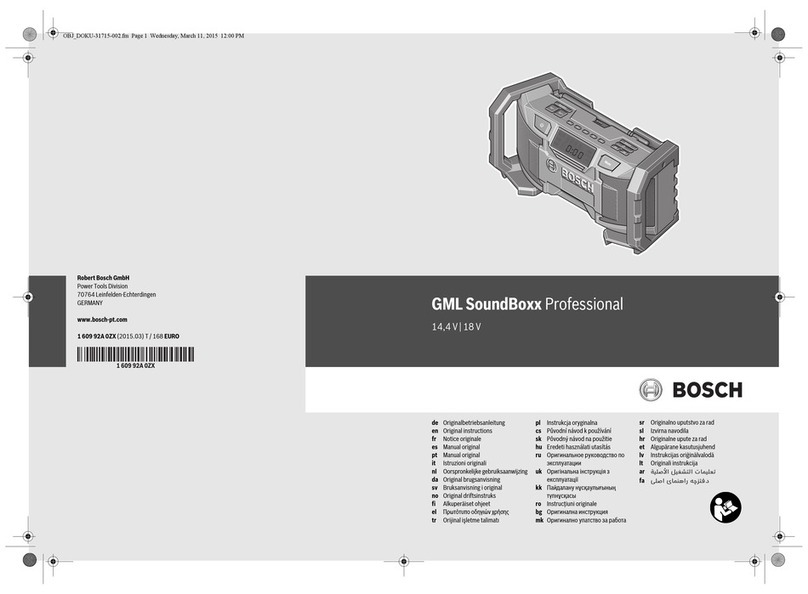
Bosch
Bosch GML SoundBoxx Professional 18 V Original instructions
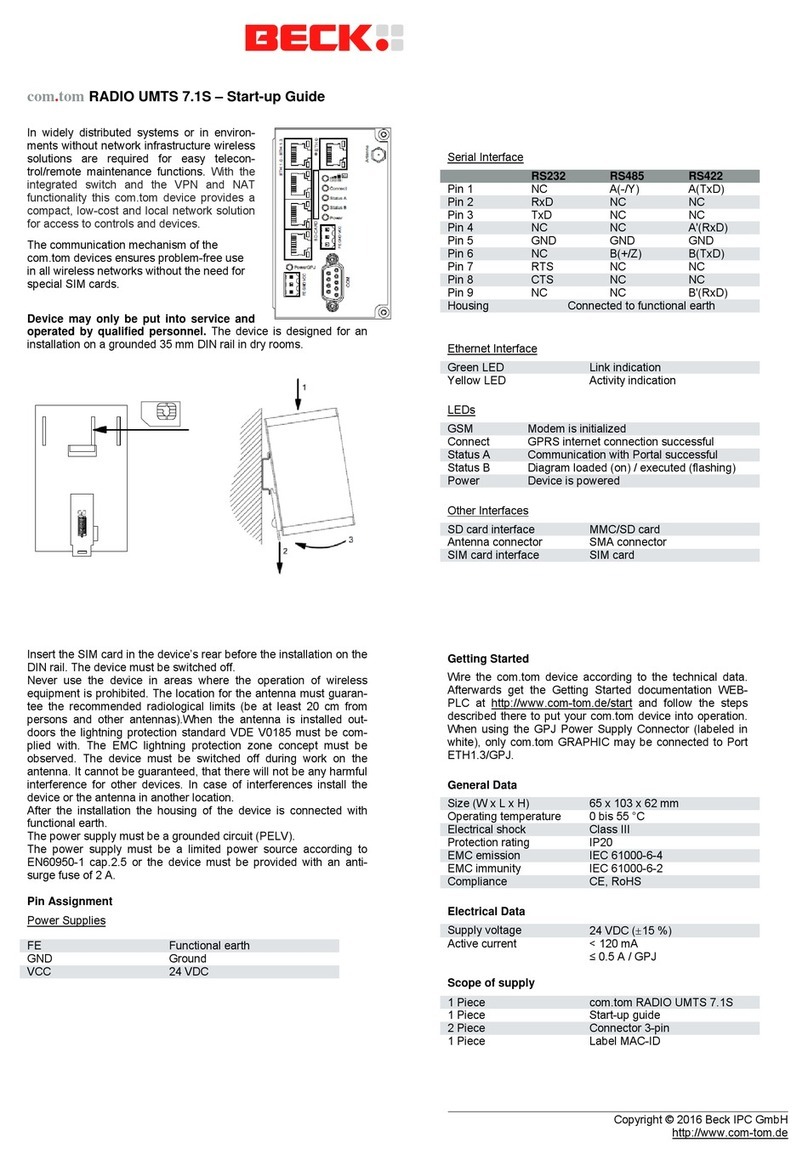
Beck
Beck UMTS 7.1S Startup guide

Tivoli Audio
Tivoli Audio NetWorks Speaker owner's manual

Schwaiger
Schwaiger RADK0001 USER GUIDE AND SAFETY INSTRUCTIONS

Bang & Olufsen
Bang & Olufsen Beolit TR 36 manual
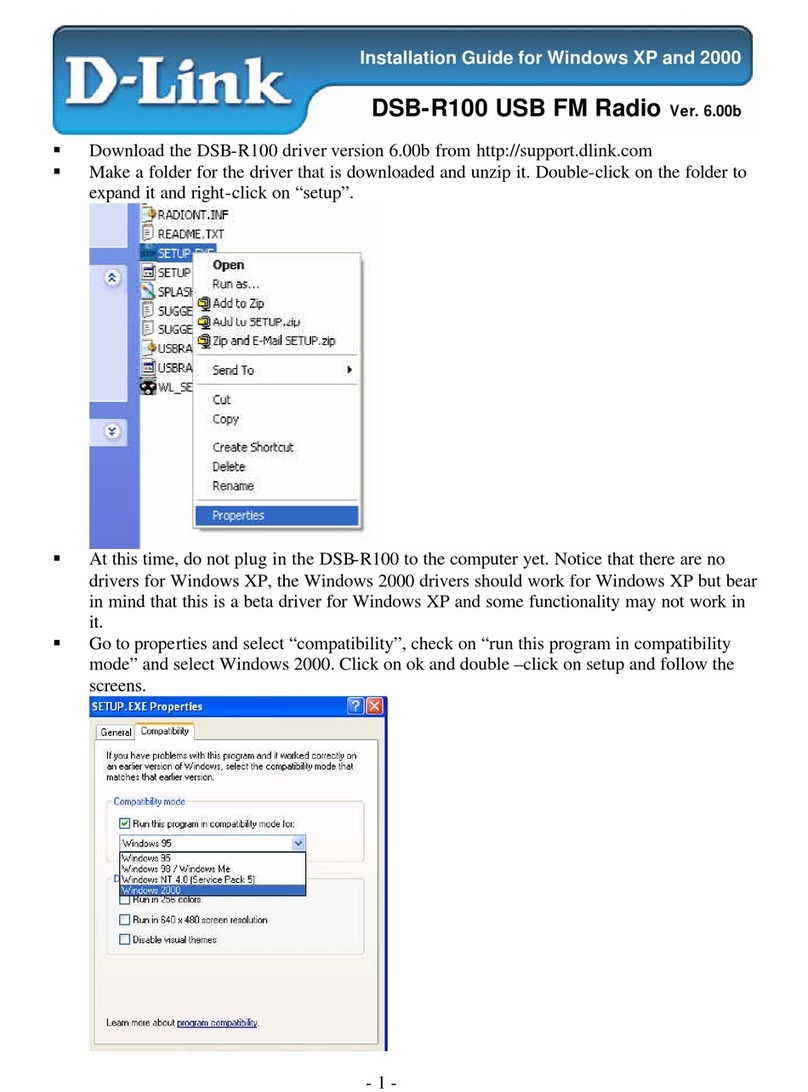
D-Link
D-Link DSB-R100 installation guide
